REAL ID: New Deadline Announced for Air Travel ID Requirements
Update: real id deadline postponed to 2023.
*Due to circumstances resulting from the COVID-19 pandemic and the national emergency declaration, the Department of Homeland Security is extending the REAL ID enforcement deadline (again.) Now, the new deadline for REAL ID enforcement is October 1, 2023. (More details) .
Now, according to the Department of Homeland Security’s Secretary
As our country continues to recover from the COVID-19 pandemic, extending the Real ID full enforcement deadline will give states needed time to reopen their driver’s licensing operations and ensure their residents can obtain a Real ID-compliant license or identification card. Alejandro N. Mayorkas
Beginning * October 1, 2023 , every air traveler 18 years of age and older will need a REAL ID-compliant driver’s license, state-issued enhanced driver’s license, or another acceptable form of ID to fly within the United States.
A little more than a year away, the TSA is changing its identification requirements. Here’s exactly what this means for you, and how TSA “REAL ID” protocol affects future air travel. Effective on Oct. 1, 2020 ( Extended to October 1, 2023 ) travelers will not be allowed to board a flight without a REAL ID , or some kind of alternative identification such as a passport.
If you have been inside an airport recently, you may have seen signage at TSA checkpoints that announce there are going to be changes to what constitutes an acceptable ID for air travel.
In fact, the TSA has begun an awareness program to educate flyers. At many TSA checkpoints (where they verify your documents) if your ID is not REAL ID Compliant, you may hear the agent say “ Beginning October 2021 you will not be allowed to fly with your current ID. ”
Well, soon, the TSA Real ID requirements will mean you must have compliant identification cards for domestic air travel.

First, What Is TSA Compliant REAL ID?
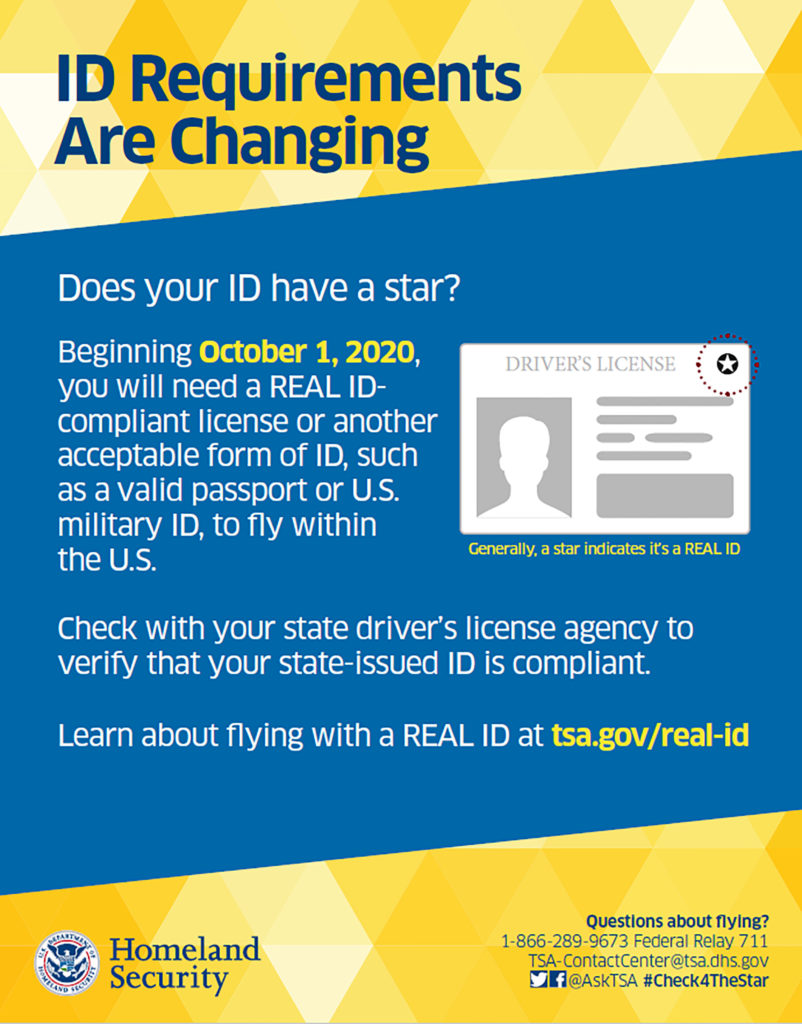
REAL ID is the result of congressional legislation — one of those laws enacted after 9/11. The government passed the REAL ID Act in 2005.
The Act established specific minimum security standards for state-issued driver’s licenses and ID cards. REAL ID prohibits federal agencies from accepting those licenses and IDs from states that are not in compliance — more on that later. This legislation meant to eliminate potential airline terrorism by increasing the security requirements for documents that would give passengers access to airplanes.
What’s The Difference Between the Old & New TSA Compliant REAL IDs?
The new identification cards are being built with some newer, cutting-edge technology that will make them much harder to forge. Additionally, obtaining a state ID will require supplementary supporting documents that not all the states currently collect.
Why Are Many People Just Hearing About REAL ID Requirements Now?
It’s been a difficult and often contentious battle getting each of the fifty states into compliance with the new identification requirements. There have been delays and extensions since first enacted into law. In fact, it’s been nearly 15 years since the legislation passed and finally we are at a point where implementation in America’s airports is going to become a reality. All states must be in compliance by October 1, 2023. That’s why it’s important now to know what is going on.
How Can I Tell If My ID and My State Driver’s License Are TSA REAL ID Compliant?
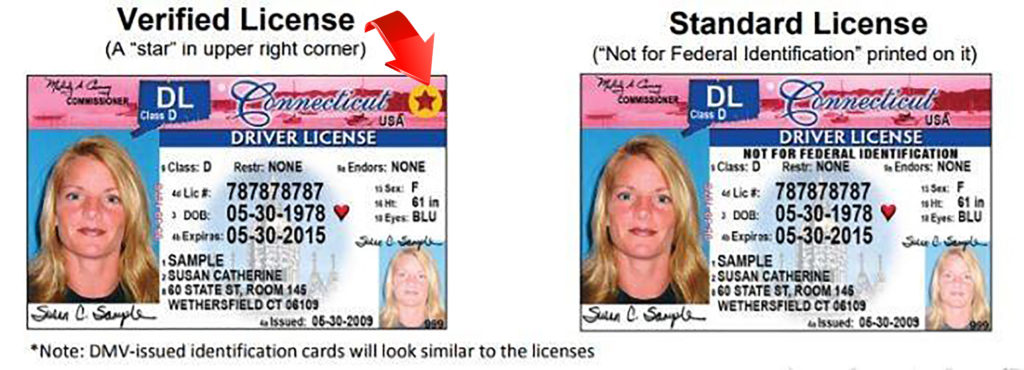
Not All ID’s Are ‘REAL ID’ Compliant
Nearly all the states with issued compliant ID’s have a black or gold star on the front of the card — in the upper right hand corner with a few exceptions.
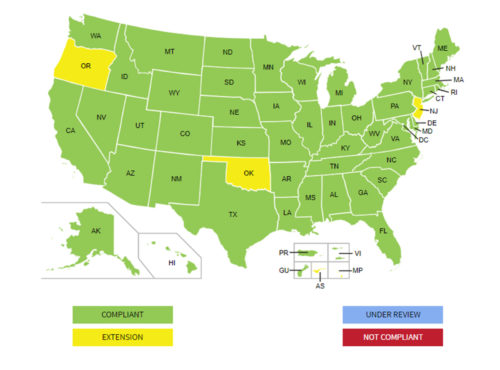
To complicate matters a bit, Hawaii, Tennessee and Utah are REAL ID compliant, but do not have the star identifier. You can check with your state Department of Motor Vehicles (DMV) if you’re not certain. State IDs not in compliance say “Not for Federal Identification” or “Federal Limits Apply.” You can check out the current list of compliant states on the Department of Homeland Security’s website.
If My State Is On That Compliant List, Then Is My ID Compliant?
Not necessarily. You may have acquired your license before it was compliant. In that case, you need to get a new and compliant ID. If your ID doesn’t have the gold or black star in the upper right corner (and it’s not from Hawaii, Tennessee or Utah,) you should visit your DMV and check to make sure your ID is compliant, or get a new ID.
If I Have TSA PreCheck Do I Need a REAL ID?
Yes, although TSA PreCheck is a great benefit to have, it will not prevent you from having to present a compliant ID to pass through a TSA security checkpoint and board a flight.
With the popularity of credit cards that include PreCheck, membership has increased overall.
If you want to get free TSA PreCheck, these credit cards include Global Entry and TSA PreCheck reimbursement, among other benefits:
- The Platinum Card from American Express
- Chase Sapphire Reserve
- Capital One Venture Rewards Card
What Happens If I Ignore This and Try to Fly With a Non-Compliant ID?
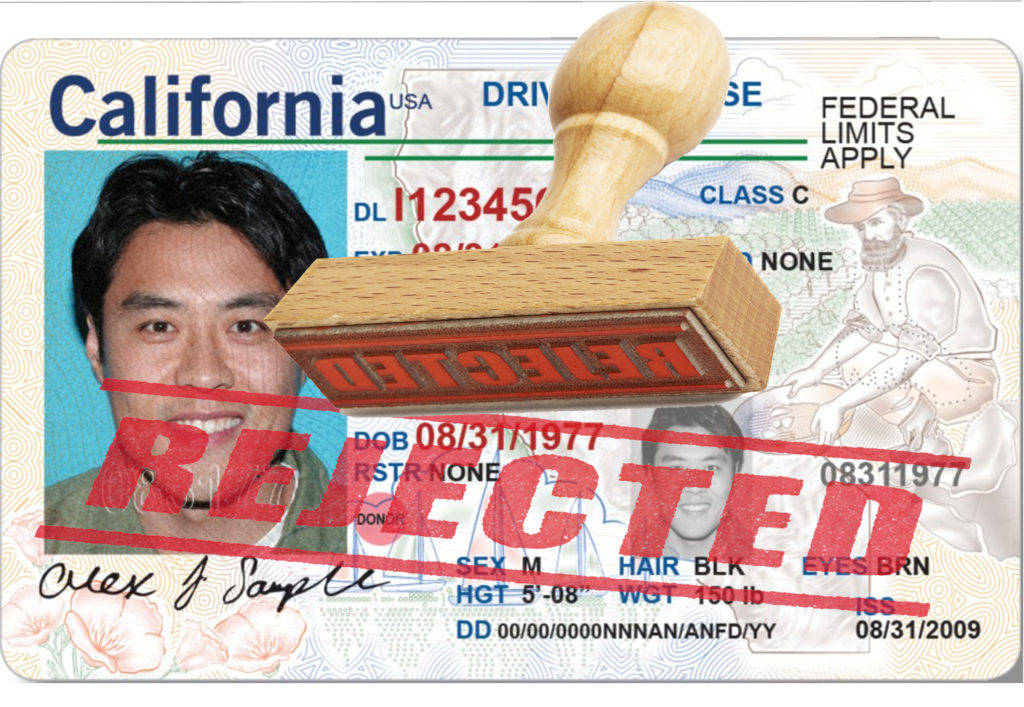
You won’t fly. Even if you have another state government issued ID, the TSA has made it quite clear that anyone who fails to present a REAL ID compliant ID will not be allowed to pass through a TSA checkpoint and board an airplane after October 1, 2023. In that case, you’ll need a passport or passport card to fly domestically.
It is up to you, the traveler, to know if your ID is compliant and to make efforts to ensure you have an acceptable ID for travel. Take steps now. You still have several months before the October 1, 2023 deadline to get the proper ID from your DMV.
Will There Be Any More Extensions?
Hey, we are talking about the US government, so anything’s possible. There have been a lot of delays and extensions as I mentioned.
But don’t count on any more as we are down to the ‘eleventh hour’ on full implementation of the REAL ID requirements. There are some real issues with getting some states to issue the REAL ID cards. For example, Alaska and California were granted an extension for the dates they must begin issuing the cards, but that does not change the TSA’s October 1, 2021 deadline for travel. If your state has been granted such an extension, you should check back often on when exactly they will issue the new ID’s.
Here is the latest extension information, provided by Department of Homeland Security
* indicates state is issuing REAL ID-compliant licenses and IDs
What Should You Do Right Now?
If you do not have REAL ID compliant license, you should first check to see if your state is already compliant.
Here’s a graphic to help you see where your state might fall in the requirements, provided by the TSA (but this is subject to change)
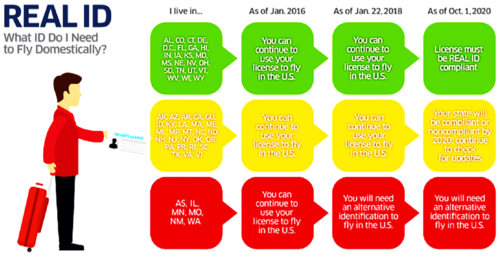
Timeline of REAL ID TSA Air Travel Requirements
If your state is compliant, you should check to see if your ID is compliant. If not, make the effort to get yourself a new ID. You probably will have to produce a verified copy of your original birth certificate and proof of a valid Social Security number to meet your state’s identification requirements.
If your state is not compliant, then contact your DMV to find out when they expect to be compliant. You’ve got some time, but make a plan to get your compliant ID. Remember, the TSA will not be enforcing these new rules until October 1, 2023.
“Homeland Security established some guidelines for all 50 states to abide by,” Secretary of State Jesse White said in May. Here’s the TSA’s checklist to get a Real ID: https://realid.ilsos.gov/checklist.html .
In addition the Secretary of State’s website has more information on the Real ID.
Start Early, Beat the Rush to Get Your TSA REAL ID
My suggestion is to start the process of getting a new ID early. Even if you don’t fly often, or don’t plan to fly in the foreseeable future, I still suggest you get a compliant ID. You never know if something might come up that required you to travel. If that happened, you wouldn’t want to be ‘grounded’ because you didn’t have proper identification.
States are making the efforts to be federally compliant and they understand that every resident will eventually need one. They are making the effort to get this done in time. But don’t delay; the rush is sure to be ugly as October 2023 approaches. I am imagining throngs of people descending upon their local DMV offices at the last moment once they realize they will be denied by the TSA if they don’t have a REAL ID compliant license (or ID card.)
Some Additional Questions Answered
Do i need a tsa compliant id to vote.
No. The REAL ID requirements neither affect voter access nor voter registration processes.
What About International Travel?
REAL ID has no effect on the requirements for international travel. Every passenger still is required to have a valid passport for international travel. You will still need your passport to leave the country.
I know there has been a lot of confusion and misinformation regarding the new TSA REAL ID air travel requirements. Please let me know in the comments section if you have any additional questions.
What About the Trusted Traveler Program, or Global Entry?
Technically, the Real ID technically is not mandatory because passengers may instead use other approved documents. This includes a passport, passport card, U.S. military ID, Enhanced ID (offered in some states) or an ID from the federal government’s Trusted Traveler Program, such as a Global Entry card.
The REAL ID Final Review
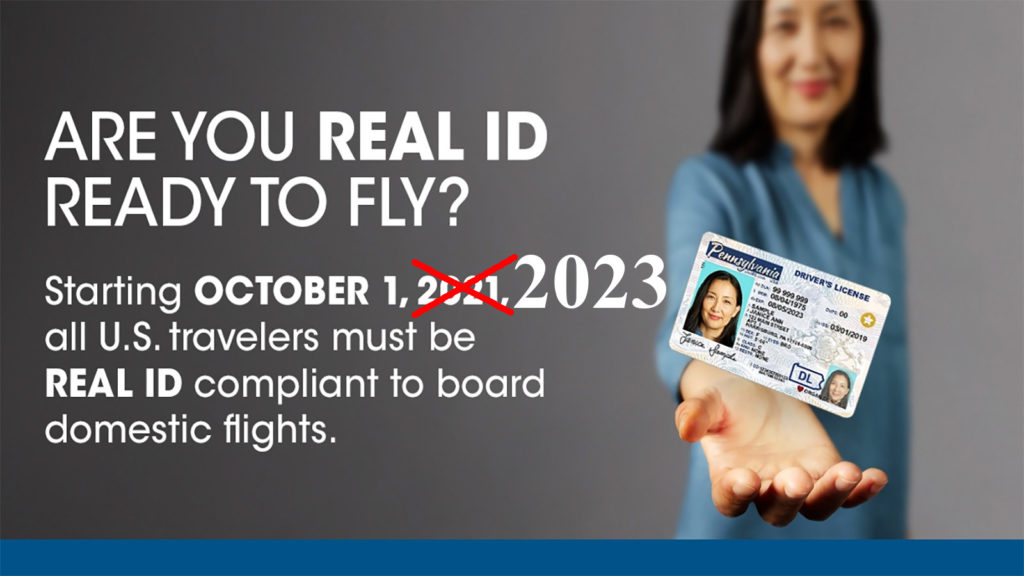
REAL ID’s will be required of all air passengers soon. October 2023 is the latest deadline set by the federal government. Beginning on October 1, 2023 , every air traveler 18 years of age and older will need a REAL ID-compliant driver’s license, state-issued enhanced driver’s license, or another acceptable form of ID to fly within the United States.
If you have more questions, please ask away in the comments below:
The responses below are not provided or commissioned by the bank advertiser. Responses have not been reviewed, approved or otherwise endorsed by the bank advertiser. It is not the bank advertiser's responsibility to ensure all posts and/or questions are answered.
Miles Jackson
Getaway guide: 10 best beaches to visit this winter (part 2), sweet spots: redeeming world of hyatt points (part 1), related articles, a gem in the heart of seoul, a culinary fiesta: exploring the best mexican restaurants..., what makes this asian capital city a gem, the every day gift-giving guide, this killer tool determines checked bag fees as..., amex offers:everything you need to know, beware the swipe: unveiling the 10 worst countries..., what makes the park hyatt melbourne a gem..., mexico city: what makes this capital a world..., southwest airlines phone number, 20 comments.
Washington state is a loser. They wanted to help illegal aliens so the DL is NOT compliant. However, they got around the law saying you can buy a more expensive “enhanced driver’s license”. Many states issue DL that are compliant but not Washington state.
Just get a passport. If you want less bulk for domestic flights, get a passport card. Works not only in US airports but all airports.
John, Great suggestion for travelers. The cost is $65 for adults (for the passport card alone.) A new US passport will run you $145 (renewal $110.) SO, if you were getting your passport for the first time ($145) and a passport card with it ($65) expect it to cost $210. Then pull out your passport card like a credit card from you wallet, billfold, purse or travel document carrier.
If you purchase a Compliant License could you then use the TSA Precheck line?
ZDENKO- No, sorry. One does not get TSA PreCheck without going through a separate process. But you’ll need a compliant ID to get through security either way.
My drivers license does not expire for another 4 years. It will cost $40 to get the enhanced one. Can I apply for a real ID for $10 and will that work to fly. I am on a fixed budget and cannot throw away money when not necessary.
Hi Gary C- Unfortunately no. You will be required to get a new driver’s license issued by your state (at whatever cost that is set by them.) The $10 is a surcharge added onto (in most jurisdictions) the standard cost for your driver’s license. You are forced to get a completely new identification (in this case, driver’s license) that complies with the REAL ID requirements.
Ohio does, in fact, offer a compliant license with white star encased in a black circle, next to a gold version of the state of Ohio. I got one in April of 2019.
Hi Mike M- Thanks for the comment. I’ve verified with the DHS website and updated the article to reflect that Ohio does have a REAL ID with a white star within a black circle, as you mentioned. Thanks for that!
Your link points to sgn archived DHS webpage.
Hi Debit – Thanks for that catch. Guess the government doesn’t maintain that list anymore. However, I have updated the post with the current map as well as new link provided by the Department of Homeland Security for the latest information on States’ compliance with the new REAL ID requirements. Thanks for reading!
How are they going to deal with people whose Real ID is lost/stolen at the destination? This could be particularly problematic if the destination (or the home state/territory) is not in the 48 contiguous states.
T- That’s a great question and one that has come a few times in my research. However, no one seems to have a definitive answer and it will probably vary greatly for each issuing State. Bottom line is it will definitely be a huge problem if someone doesn’t have a backup (i.e. passport) identification so they could board a returning flight. Thanks for your input!
I read recently that Global Entry is also acceptable. Can you verify this?
Hi Jeanie- There are a lot of misunderstandings and mis-facts about REAL ID. Those who do not plan to fly after Sept. 30, 2020, can continue to use their current state-issued driver’s license until it expires. So can air travelers who have a valid U.S. passport or passport card, a military ID, a DHS Global Entry card, a permanent resident card or a passport issued by a foreign government.
Question are TWIC cards, which provide a Known Traveler ID going to be acceptable?
Stephen- Yes, Transportation Worker Identification Credentials (TWIC®) are accepted under the REAL ID program!
Do you need to participate in the Trusted Traveler Program if you have a Real ID?
Carl- No, you do not need to participate in the Trusted Traveler Program if you have a Real ID. In fact, it also works the other way. If you have an ID in the Trusted Traveler Program (like Global Entry) you can use that ID as your REAL ID. Hopefully, that makes sense. Thanks for the question, which I know may help other readers.
[…] TSA Real ID FAQs: A Complete Guide To Requirements […]
Leave a Comment Cancel Reply
Save my name, email, and website in this browser for the next time I comment.
- Share full article
Advertisement
Supported by
Planning to Fly? You’ll Need This ID.
For years, the government has warned travelers they will need a security-enhanced Real ID to board domestic flights, and for years the requirement has been delayed. Now they mean it.

By Debra Kamin
It’s a change nearly 20 years in the making: a post-Sept. 11 law requiring that U.S. travelers carry more than a standard driver’s license to board a domestic flight. Now, after years of delays, it is finally kicking into gear.
Beginning May 3, 2023, U.S. travelers flying within the United States will need to show Transportation Security Administration agents either a security-enhanced driver’s license that’s Real ID-compliant or another T.S.A.-approved form of identification like a passport. A state driver’s license that does not contain the Real ID seal will no longer be accepted.
What is Real ID, anyway?
Real ID is a driver’s license or identification card that bears a special seal, which signifies that the bearer of the card has been screened and approved according to a standard set by the federal government, rather than just by the state issuing the license.
Why is this change taking place?
In the wake of the Sept. 11 attacks, the U.S. government realized that nearly all of the hijackers who boarded commercial planes and crashed them into the World Trade Center in New York, the Pentagon in Washington, D.C., and a field in Shanksville, Penn., were carrying U.S. driver’s licenses and state IDs, and most of those documents had been obtained fraudulently.
In the years that followed, the federal government began an effort to tighten national standards for state-issued documentation, and in 2005, Congress passed the Real ID Act. The act sets minimum standards for driver’s licenses and other types of identification cards. Once the law kicks into gear, any traveler who wishes to use a driver’s license or state-issued ID at a T.S.A. checkpoint must make sure that it is Real ID-compliant.
“The findings of the 9/11 Commission clearly identified gaps in security management of state-level procured identity cards and driver’s licenses,” said Frank Harrison, the North America regional security director for World Travel Protection , a risk management company. “The Real ID Act provides a national framework of screening and approval to ensure consistency and integrity of programs. In other words, each state will maintain authority over their ID issuances, but they collectively will adhere to one standard of practice.”
The Real ID Act was initially set to be enforced in 2008 and has been delayed a number of times.
“It’s remarkable how long it has taken for this to come into effect,” said Scott Keyes, the founder of the travel platform Scott’s Cheap Flights . “It’s been decades in the making.”
How do I know if my license is a Real ID?
The easiest way to tell is just to look at it. Real ID-compliant driver’s licenses have a star, usually in gold or black. The stars look slightly different on each state’s licenses — in California, it sits on top of an image of a bear, which is the state animal.
A license that is not Real-ID compliant will not have a star in the corner, and some will also have the words “federal limits apply.”
Can I get a Real ID regardless of where I live?
Real ID-compliant licenses and identification cards are now being issued in all 50 states as well as the District of Columbia and the majority of U.S. territories. American Samoa is not yet issuing them.
What do I need to get a Real ID?
Each state has a different process for applying for a Real ID, so applicants should check requirements online. New Yorkers can visit a special Department of Motor Vehicles page detailing the process; many other states, including California and Texas, offer similar sites either through their D.M.V. or government portals. In most instances, you can get a Real ID by visiting your local D.M.V., either as part of a standard license renewal or by filling out a special application.
But no matter where you live, to apply for a Real ID or change your license over, you’ll need to provide a Social Security number, prove your address through documents like a utility bill or bank statement, and verify your identity through a handful of additional documents like a birth certificate or passport.
In many instances, there is no additional cost to receive a Real ID if you’re already renewing your license, although some states charge extra — in Pennsylvania, for example, it’s an additional $30 on top of the renewal fee.
If I don’t get a Real ID, can I still fly?
Yes. There are a number of other forms of identification that T.S.A. agents will accept for domestic air travel starting in May. These include a passport, a permanent residency card (also known as a Green Card), or the card for trusted traveler programs, including Global Entry and NEXUS , which allows pre-screened travelers to transit quickly across the United States-Canada border.
In addition, a handful of states — Minnesota, Michigan, New York, Washington and Vermont — offer Enhanced Driver’s Licenses , or E.D.L.s. Some travelers may prefer to opt for these over a Real ID because they can also be used at some land or sea border crossings. They provide proof of U.S. citizenship, much like a passport, and are equipped with a radio-frequency identification (RFID) chip that can display biographic and biometric data on the owner, including facial image, gender, date of birth and citizenship status, to U.S. Customs and Border Protection agents.
E.D.L.s are Real ID-compliant, as well, although instead of a star, they have an American flag. The flag’s location varies by state.
E.D.L.s can be used by travelers crossing land and sea borders to Canada, Mexico, Bermuda and the Caribbean, but they can’t be used in lieu of a passport if you’re traveling anywhere by air.
Do children need a Real ID?
No. The T.S.A. doesn’t require kids under the age of 18 to show any identification right now when they’re traveling domestically with an adult.
For international travel, children of all ages are required to carry passports and that will continue.
Can a Real ID be used as a replacement for any other form of identification, like a passport?
It can’t. For the vast majority of travelers, becoming Real ID-compliant will be a matter of simply updating their driver’s licenses. Real IDs cannot be used at any international border, including land crossings with Canada and Mexico, and they can’t be used for sea travel on a cruise, either. International travelers will still be required to carry a passport.
Should I be concerned about my personal privacy?
Maybe. Many organizations, including the American Civil Liberties Union of New York, have decried the Real ID Act as a threat to personal privacy and an overstep of information gathering on the part of the federal government.
“A lot of the security and privacy concerns revolve around the fact that it’s pushing every state’s D.M.V. into a national database,” said Anaya Robinson, a senior policy strategist for the A.C.L.U. of Colorado. “If someone were to hack that singular database, they could get the personal information of anyone.”
For undocumented immigrants who seek out driver’s licenses so they can legally operate a motor vehicle, the shift to Real ID also presents a threat, Mr. Robinson added. “There’s a severe privacy concern in the immigration space of the federal government, Homeland Security and I.C.E. being able to access that information,” he said.
In addition to centralizing personal data like addresses and citizenship status into a federal database, the cards also carry a machine-readable zone that can be scanned for information on the card owner’s identity, which detractors say also presents a risk of identify theft.
But only 37 percent of Americans have a passport, according to estimates from the U.S. State Department, so if you plan to fly after May 2023 and don’t want to scramble with alternative documentation, you’ll need to update your driver’s license.
Follow New York Times Travel on Instagram , Twitter and Facebook . And sign up for our weekly Travel Dispatch newsletter to receive expert tips on traveling smarter and inspiration for your next vacation. Dreaming up a future getaway or just armchair traveling? Check out our 52 Places for a Changed World for 2022.
An earlier version of this article misstated the location of the American flag on Enhanced Driver’s Licenses. While the flag often appears in either the upper right corner or the bottom right corner of a driver’s license, in some cases it appears elsewhere on the license, depending on the state.
An earlier version of this article misstated the location of the star that indicates a driver’s license is Real ID-compliant. While the star is usually in the top upper corner of the license, occasionally, as in the instance of Alabama licenses, it is not.
How we handle corrections
Open Up Your World
Considering a trip, or just some armchair traveling here are some ideas..
52 Places: Why do we travel? For food, culture, adventure, natural beauty? Our 2024 list has all those elements, and more .
Mumbai: Spend 36 hours in this fast-changing Indian city by exploring ancient caves, catching a concert in a former textile mill and feasting on mangoes.
Kyoto: The Japanese city’s dry gardens offer spots for quiet contemplation in an increasingly overtouristed destination.
Iceland: The country markets itself as a destination to see the northern lights. But they can be elusive, as one writer recently found .
Texas: Canoeing the Rio Grande near Big Bend National Park can be magical. But as the river dries, it’s getting harder to find where a boat will actually float .
What Is Real ID? Everything You Need To Know About The New TSA Requirement.
On assignment for HuffPost
If you’ve had the pleasure of standing in line at airport security recently, you’ve probably noticed the big blue signs warning travelers of new identification requirements coming next year. If you haven’t, you may have no idea that your driver’s license or other state-issued ID could soon become obsolete for air travel.
As of Oct. 1, 2020, every adult needs to show a Real ID -compliant driver’s license (or another acceptable form of identification such as a passport) to fly within the United States. If you don’t have one, you’re not going anywhere ― even if you’re traveling domestically. You’ll also need one to enter a secured federal facility that requires ID.
But what, exactly, is a Real ID? And how do you get one? We have the answers to all your Real ID-related questions below.
What Is A Real ID?
Back in 2005, Congress passed the Real ID Act in response to the 9/11 Commission’s recommendation that identification requirements be tightened. The act establishes minimum security features and bars federal agencies from accepting any ID that doesn’t meet those specifications. However, since most of us carry state-issued IDs, states had to be given time to implement these changes. That’s why we haven’t heard much about the Real ID and its upcoming deadline until fairly recently.
Included among these new security requirements are features that make counterfeiting more difficult. Holograms are often used for this purpose. All Real IDs will also have a barcode that can be easily scanned to pull up information such as the holder’s full name, birth date, license number and more. And according to the act, all the documents presented by Real ID applicants for identity and residency verification must be scanned and stored in a database ― including birth certificates and Social Security cards ― even if those people are denied an ID.

It’s important to note that a Real ID is required only for entering airport security checkpoints and boarding aircraft, as well as entering secured federal facilities and nuclear plants. It’s not required in other instances when you might be asked to show ID, such as voting or registering to vote, applying for or receiving federal benefits, accessing health- or life-preserving services, and more. And if you’re traveling internationally, you’ll still need a valid passport.
“TSA is doing everything we can to prepare our partners and the traveling public for the REAL ID deadline next year,” David Pekoske, administrator of the Transportation Security Administration, stated in an April press release . “The security requirements of the REAL ID Act will dramatically enhance and improve commercial aviation security.”
Despite the TSA’s efforts to educate the public about this new requirement, plenty of people are still unaware or confused about the rules and deadlines. Participation is voluntary on the state level, and earlier pushback by some states over the Big Brother-like nature of the law led to the delayed rollout of some Real IDs. Most states are now in compliance, but a few have needed extensions of their deadlines to various dates throughout 2019. California is currently under review and must reach compliance by May 24, 2019 (you can check your state’s compliance status here ).
If you live in a compliant state but still have your “regular” ID, you can keep using it until Sept. 30, 2020. But on Oct. 1 of that year, you’ll need to have one with a star in the top right corner, which signifies you’ve upgraded.
However, if your state received an extension to reach compliance, you can only keep using your old ID until that extension expires. After that, you might need an additional or alternate form of ID between the extension expiration and Sept. 30, 2020. By Oct. 1, 2020, everyone in those states will need to have the Real ID with a star symbol as well.
The bottom line is this: If you don’t have a Real ID, you should probably get one ASAP.
How To Get A Real ID
Everyone age 18 and up will need to meet these new standards for identification. Minors don’t have to show ID to fly, as long as they’re accompanied by an adult who has proper ID.
You won’t be able to get a Real ID online or through the mail ― you’ll have to visit a DMV office in person (sorry). You’ll need to bring the following:
- An original or certified document that proves your identity, such as a passport or birth certificate. Photocopies won’t be accepted.
- A document that shows your Social Security number, such as a W-2 form.
- Two documents that prove your residency, including your street address, such as a utility bill, rental agreement or mortgage statement. You can use photocopies for these.
- If you’ve changed your legal name, you’ll need additional original or certified documents.
- Cash, check or debit card to pay the fee. The cost varies by state, but it’s usually less than $60.
It’s a good idea to contact your local DMV before showing up in order to verify what types of documents are accepted.
Other Acceptable Forms Of ID
If you need to fly and, for some reason, haven’t received your Real ID yet, you’re not completely out of luck. The TSA lists a handful of other approved forms of identification that you can use instead :
- Valid U.S. passport or passport card
- DHS trusted traveler cards (Global Entry, NEXUS, SENTRI, FAST)
- U.S. Department of Defense ID, including IDs issued to dependents
- Permanent resident card
- Border crossing card
- DHS-designated enhanced driver’s license
- Federally recognized, tribal-issued photo ID
- HSPD-12 PIV card
- Foreign government-issued passport
- Canadian provincial driver’s license or Indian and Northern Affairs Canada card
- Transportation worker identification credential
- U.S. Citizenship and Immigration Services Employment Authorization Card (I-766)
- U.S. Merchant Mariner Credential
The TSA notes that a temporary license or weapons permit will not count as proper identification.
Since the deadline to upgrade to a Real ID is approaching, you might find that DMV offices are busier than usual. In fact, appointments might not be available for several weeks. So make sure you don’t wait until the last minute and get an appointment as soon as you can.
From Our Partner
Huffpost shopping’s best finds, more in life.
An official website of the United States government
Here’s how you know
Official websites use .gov A .gov website belongs to an official government organization in the United States.
Secure .gov websites use HTTPS A lock ( Lock Locked padlock icon ) or https:// means you’ve safely connected to the .gov website. Share sensitive information only on official, secure websites.

How to get a REAL ID and use it for travel
The REAL ID Act is a law that sets higher security standards for state-issued driver's licenses and identification cards (IDs).
Why upgrade your license to a REAL ID?
Beginning May 7, 2025, if you have not upgraded your driver’s license or state-issued ID to be REAL ID-compliant, you will not be able to use it to:
- Board federally regulated commercial aircraft
- Access federal government facilities or military installations
- Enter nuclear power plants
Visit the REAL ID website for more details and frequently asked questions .
Check to see if your license or state ID is already REAL ID-compliant
If your driver's license or state ID has a star in the upper right-hand corner, it is already REAL-ID-compliant. There is nothing more you need to do.
How to get a REAL ID
When you apply for or renew your driver’s license or state identification card, you can choose to make it REAL ID-compliant. Find and visit your state's driver's licensing agency website to see what documentation you will need. Your new card will have the REAL ID star marking at the top right.
Using REAL ID and other ID options to board a plane
If you do not upgrade your license or state ID, you can use a passport or one of these other acceptable forms of identification to fly .
Can you still get a non-REAL ID-compliant license or state ID?
You will still be able to get a driver's license or state ID card that is not REAL ID-compliant. But you will not be able to use it for air travel or to get into federal facilities or military installations. Find and visit your state's driver's licensing agency website to see how to get a non-REAL ID-compliant license or state ID.
LAST UPDATED: December 18, 2023
Have a question?
Ask a real person any government-related question for free. They will get you the answer or let you know where to find it.
Advertiser Disclosure
Many of the credit card offers that appear on this site are from credit card companies from which we receive financial compensation. This compensation may impact how and where products appear on this site (including, for example, the order in which they appear). However, the credit card information that we publish has been written and evaluated by experts who know these products inside out. We only recommend products we either use ourselves or endorse. This site does not include all credit card companies or all available credit card offers that are on the market. See our advertising policy here where we list advertisers that we work with, and how we make money. You can also review our credit card rating methodology .
The REAL ID Act: What It Means, State by State Requirements, and Updates [2024]
Christy Rodriguez
Travel & Finance Content Contributor
87 Published Articles
Countries Visited: 36 U.S. States Visited: 31
Jessica Merritt
Editor & Content Contributor
82 Published Articles 471 Edited Articles
Countries Visited: 4 U.S. States Visited: 23
Keri Stooksbury
Editor-in-Chief
31 Published Articles 3102 Edited Articles
Countries Visited: 45 U.S. States Visited: 28
![tsa air travel id requirements The REAL ID Act: What It Means, State by State Requirements, and Updates [2024]](https://upgradedpoints.com/wp-content/uploads/2018/10/Real-ID-Act.png?auto=webp&disable=upscale&width=1200)
What Is the REAL ID Act?
What does a real id look like, what does real id mean for me, what the real id act is not, common reasons to obtain a real id, reasons you may not need a real id, who can get a real id, what if my state is real id-compliant, which states require real id to fly, common problems with obtaining a real id, can i transfer my real id between states, is real id mandatory to fly, potential state revenue, what about minors under 18, final thoughts.
We may be compensated when you click on product links, such as credit cards, from one or more of our advertising partners. Terms apply to the offers below. See our Advertising Policy for more about our partners, how we make money, and our rating methodology. Opinions and recommendations are ours alone.
You may have noticed Transportation Security Administration signs posted at airport security checkpoints warning travelers about upcoming ID requirement changes. So what exactly are these changes, and what do you need to do to be ready?
We’ll break down exactly how REAL ID works — including what the REAL ID Act means for you and how you travel.
Formulated in the wake of September 11 and passed by Congress in 2005, the REAL ID Act was passed to “set standards for the issuance of sources of identification, such as driver’s licenses.”
The act established minimum security standards for state-issued driver’s licenses and identification cards and it prohibits federal agencies from accepting licenses and identification cards for official purposes from states that do not meet these standards.
It was aimed at thwarting airline terrorism by increasing requirements to obtain documents that grant access to domestic planes.
State agencies that issue licenses and identification cards, like the Department of Motor Vehicles, require more paperwork regarding proof of residency and Social Security numbers to obtain standard licenses under the new act.
The cards also use new technology, making them much more difficult to forge.
Due to various roadblocks and the COVID-19 pandemic, it will have taken the federal government nearly 20 years to implement the act fully — a gradual process that has been met by some confusion as each state has a different status. The original date of compliance was October 1, 2020. However, due to the COVID-19 pandemic, the deadline was first delayed to October 1, 2021, then to May 3, 2023, and now to May 7, 2025. All states must comply by May 7, 2025 .
We know a lot of travelers are concerned that they will lose the ability to fly, drive, or vote as a result of the REAL ID Act, but this isn’t the case. You can continue to use your regular license or identification to drive and vote without obtaining a REAL ID.
The change will only impact domestic travel in the U.S. and you will either need to provide an alternate form of TSA-approved ID or obtain a REAL ID.
Bottom Line: To fly internationally, you will always need your passport.
In most states, there is a gold or black star on the front of the REAL ID license that signifies compliance. If you see one of these stars, then you’re good to go.
There are 5 states — Michigan, Minnesota, New York, Vermont, and Washington — that issue enhanced driver’s licenses (EDLs). These are a form of REAL ID. These EDLs allow land and sea border crossings to Canada, Mexico, and the Caribbean. Michigan, Minnesota, New York, and Vermont offer the EDL as an option. Washington only issues EDLs.
Hot Tip: Enhanced IDs aren’t a substitute for passports for air travel, only land or sea travel.
An easy way to know your card is not compliant is if it says “Not for Federal Identification,” “Federal Limits Apply,” or “Not for Real ID Act Purposes.”
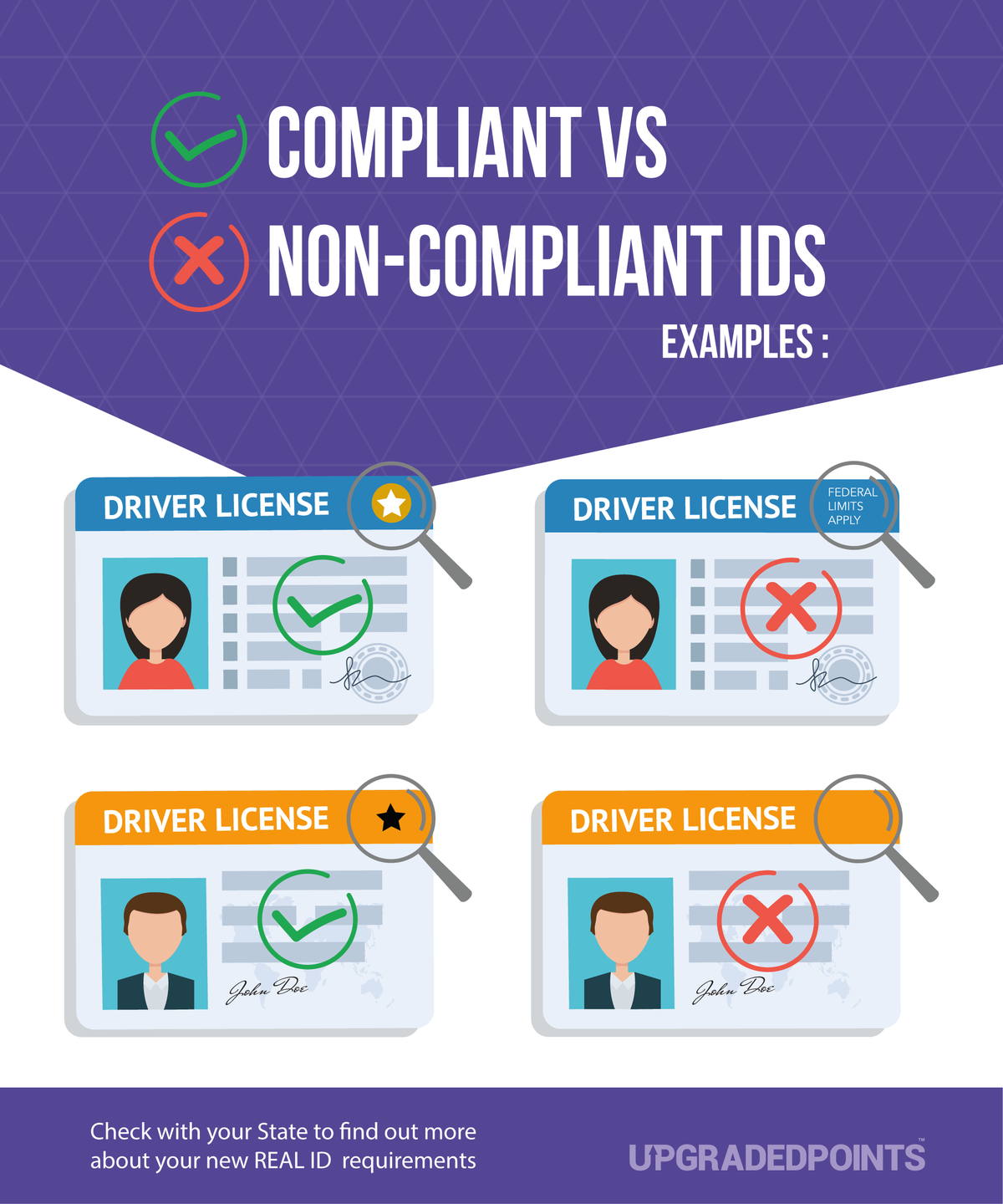
Airports are considered federal facilities and this act affects your ability to enter them and board your flight.
Starting May 7, 2025, the REAL ID Act takes full effect. From this date, every state and territory resident will need to present a REAL ID-compliant license or ID or another acceptable form of identification such as a passport or passport card to access federal facilities — including boarding commercial aircraft.
Most states and territories have already begun issuing new licenses. You will have until May 7, 2025, to obtain a REAL ID-compliant license. Just check your license to be sure.
If your ID is REAL ID-compliant, there will be a star in the top right corner. Many drivers may not realize they already have a compliant ID since some states have issued them for many years.
Bottom Line: If you are not in compliance with the REAL ID Act, you will need to show an alternative form of acceptable identification for domestic air travel to board your flight starting on May 7, 2025.
A REAL ID is NOT a substitute for a passport for international travel . This means you can’t use a REAL ID to enter Canada or Mexico by land or any international travel destination. The only exception to this is if you have an enhanced driver’s license — more on this below!
There are several other requirements that REAL ID doesn’t affect.
REAL ID requirements don’t apply to:
- Voting or registering to vote
- Applying for or receiving federal benefits
- Being licensed by a state to drive or rent a car
- Entering federal facilities that do not require identification (including a defendant’s access to court proceedings, national parks, and Social Security offices)
- Accessing health- or life-preserving services (including hospitals and health clinics)
- Participating in law enforcement proceedings or investigation
- The ability to purchase alcohol, cash checks, or gamble
You can also continue to use your standard driver’s license or ID card for other U.S. travel including driving in and across state lines or riding a train.
Who Needs a REAL ID?
In most instances, obtaining a REAL ID isn’t required, but there are many benefits to obtaining a REAL ID. Here is a breakdown of some common reasons to consider getting a REAL ID and a few reasons why you might not need one.
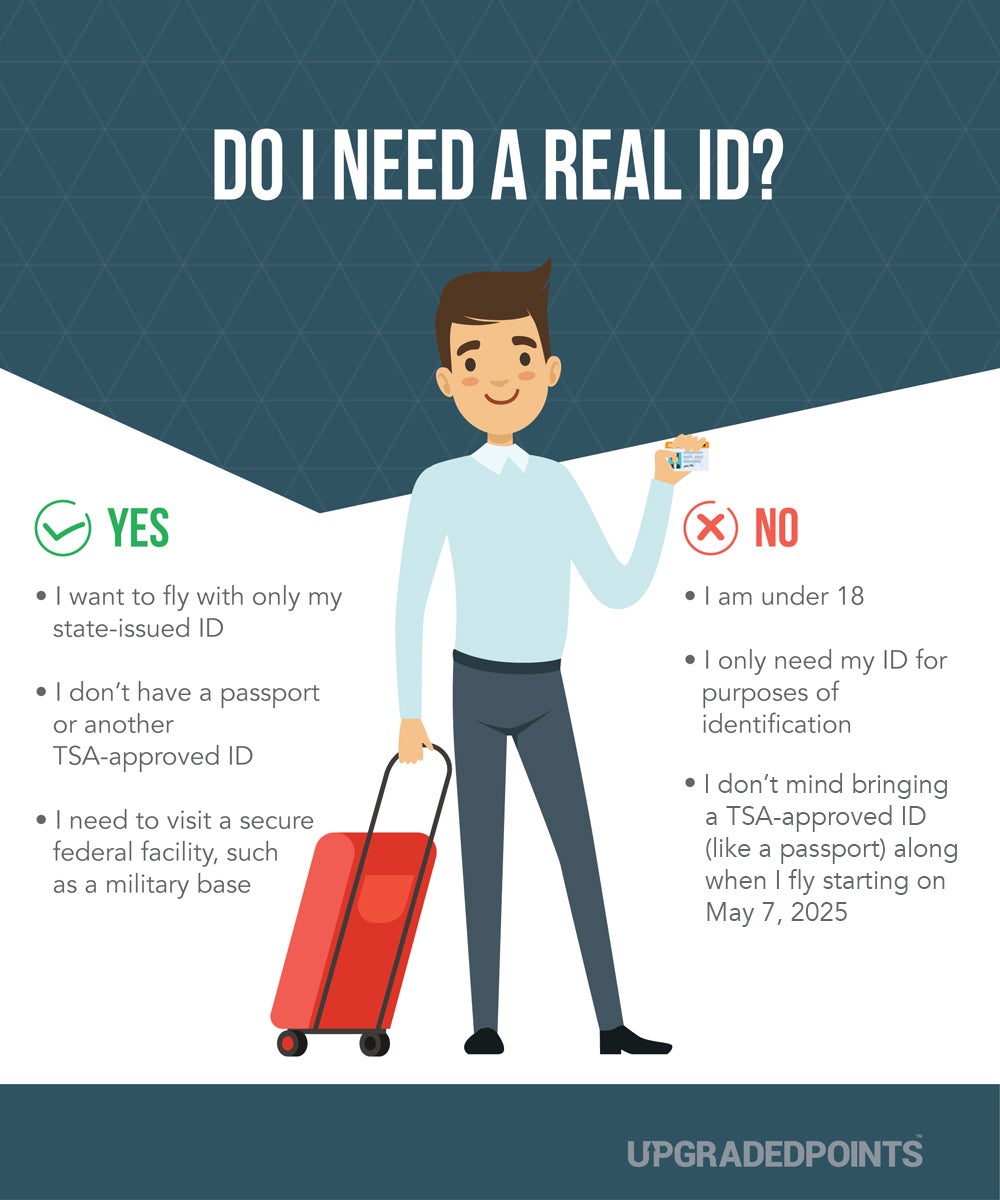
- You want to fly with only your state-issued ID
- You don’t have a passport or another TSA-approved ID (listed below)
- You need to visit a secure federal facility, such as a military base, and don’t have a military ID
- You are under 18 years old
- You only need your ID for purposes of identification (ie. to vote, serve on a jury, or drive)
- You don’t mind bringing another TSA-approved ID (like a passport) along when you fly starting on May 7, 2025
To qualify for a REAL ID-compliant ID or license, you must fall under one of the following categories:
- U.S. citizen or national
- U.S. lawful permanent resident or lawful temporary resident (including green card holders)
- Have conditional permanent resident status in the U.S. (including individuals with valid work permits, like H1B visas)
- Have an approved asylum application or entered under refugee status
- Have a valid, unexpired nonimmigrant visa
- Have a pending application for asylum
- Have a pending or approved temporary protected status
- Have an approved deferred action status (including DACA)
- Have a pending application for adjustment of status to that of lawful permanent or conditional resident
Specifically, for undocumented immigrants, the DHS website notes that driver’s licenses and identification cards can still be issued by the state, but not REAL IDs: “Some states currently issue noncompliant cards to undocumented individuals. Noncompliant cards must clearly state on their face that they are not acceptable for REAL ID purposes and must use a unique design or color to differentiate them from compliant cards.”
Hot Tip: Still not sure? Check DHS’s interactive tool to check if you are “REAL ID Ready”.
REAL ID by State
Since licenses are issued at the state level, each process is slightly different. But the good news is that all states are in compliance with the REAL ID Act. This just means that each state and territory is now able to provide REAL IDs.
In a move aimed to help more people receive their REAL IDs before the May 7, 2025, deadline, the DHS passed the REAL ID Modernization Act that allows you to submit your identification documents electronically . This includes information such as a birth certificate and passport.
Applicants will still need to bring the required documents in person so they can be compared to the electronic submissions. This means that to get a REAL ID-compliant license, you must still physically go to a DMV office.
Bottom Line: States will not send you a REAL ID-compliant license automatically if you renew your license online. While most states are issuing compliant IDs, individuals may still choose not to upgrade their licenses.
You will be able to use your state-issued ID at airports through May 7, 2025. After May 7, 2025, you will need a REAL ID (or another TSA-approved ID) to fly — both domestically and internationally.
All states issue REAL ID-compliant IDs, but none require a REAL ID. You can still fly as long as you have a TSA-approved form of ID. When comparing a REAL ID to a state ID, they can be the same form of identification.
Steps To Take To Get a Compliant REAL ID
If you’ve decided you’d like to get a REAL ID, you’ll definitely want to know where to go to get a REAL ID, what documents to bring, and how much the REAL ID costs.
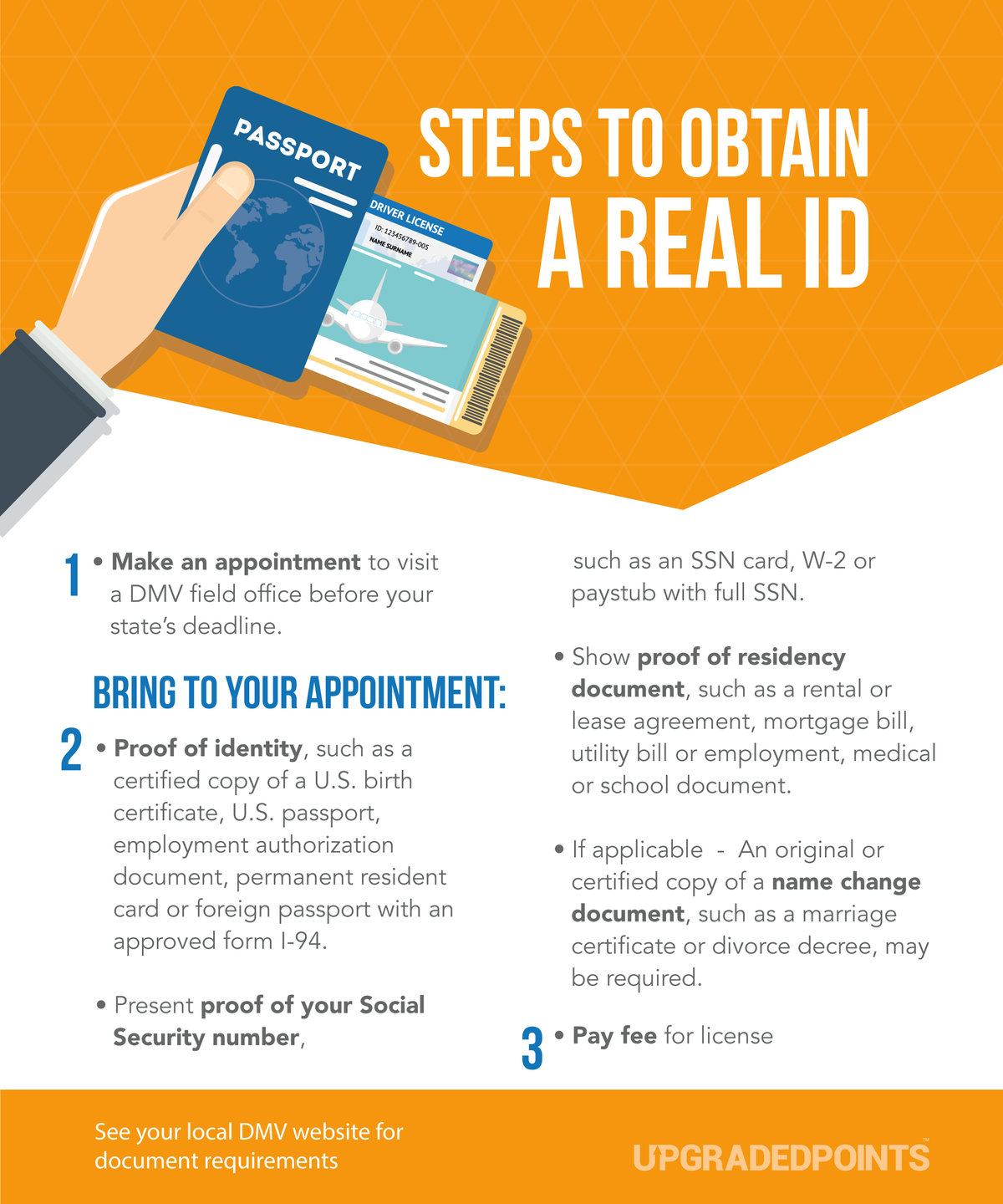
Step 1: Make an appointment to visit a REAL ID at a DMV field office near you. Some offices are offering special hours or days for those trying to get a REAL ID before May 7, 2025. You can also get a REAL ID without an appointment, but this isn’t recommended as wait times at your local office can be incredibly long.
Here are the links to all of the local offices to help you get started with this process.
Step 2: On the day of your appointment, ensure you bring all the necessary documents (even if you have submitted documents online beforehand).
What Real ID Documents Do I Need?
- Proof of identity, such as a certified copy of a U.S. birth certificate, U.S. passport, employment authorization document, permanent resident card, or foreign passport with an approved form I-94
- Proof of your Social Security number, such as an SSN card, W-2, or paystub with full SSN
- At least 2 proof of residency documents, such as a rental or lease agreement, mortgage bill, utility bill or employment, medical, or school document
- If applicable, an original or certified copy of a name change document, such as a marriage certificate or divorce decree, may be required
If you have any issues or concerns with obtaining any of the documents or seeing if an item will be accepted, we suggest checking directly with your local DMV.
Step 3: Pay the fee for the license. This will vary by state but is generally less than $60. Check our graphic under “How Much Does a REAL ID Cost?” below for specific costs.
There are a lot of questions about what is and isn’t an appropriate document to bring along with you to obtain a REAL ID. Issues like not having a mailing address, having a name change, or having a temporary or expired license are common problems. Also, getting a REAL ID without key documents such as a birth certificate, Social Security card, or passport can be a challenge.
If you’re unsure, we always recommend reaching out to your state’s license-issuing office directly before you head to your appointment!
Some states, like California, offer a l ist of documents that are accepted for each category. This is a good place to start when gathering your documents. Look for notes about when copies or originals are necessary and read recommendations for alternatives if you don’t have the recommended residency documents or if you use a P.O. Box.
No, you can’t transfer your REAL ID between states. Unfortunately, federal requirements don’t allow for the transfer of a REAL ID license between states. Each state is required to view and image all documentation upon original issuance in that state.
This means that when you move, you will need to go in person to present the same documentation such as a U.S. birth certificate or passport, Social Security card, and 2 proofs of residence address, as well as meet all of your new state’s issuance requirements.
On a positive note, REAL ID licenses from other states can typically be used like any other out-of-state driver’s license to waive behind-the-wheel driving tests.
As of May 2022, an estimated 137 million Americans held REAL ID-compliant driver’s licenses, U.S. passports, passport cards, military IDs, and Global Entry cards, all of which qualify as REAL ID-compliant identification. But, according to the most recent reports from the government , that is only 49% of Americans!
This means that you don’t have to upgrade your license to board your flight, but you will have to use an alternative (TSA-approved) form of ID. TSA currently accepts several other forms of identity documents:
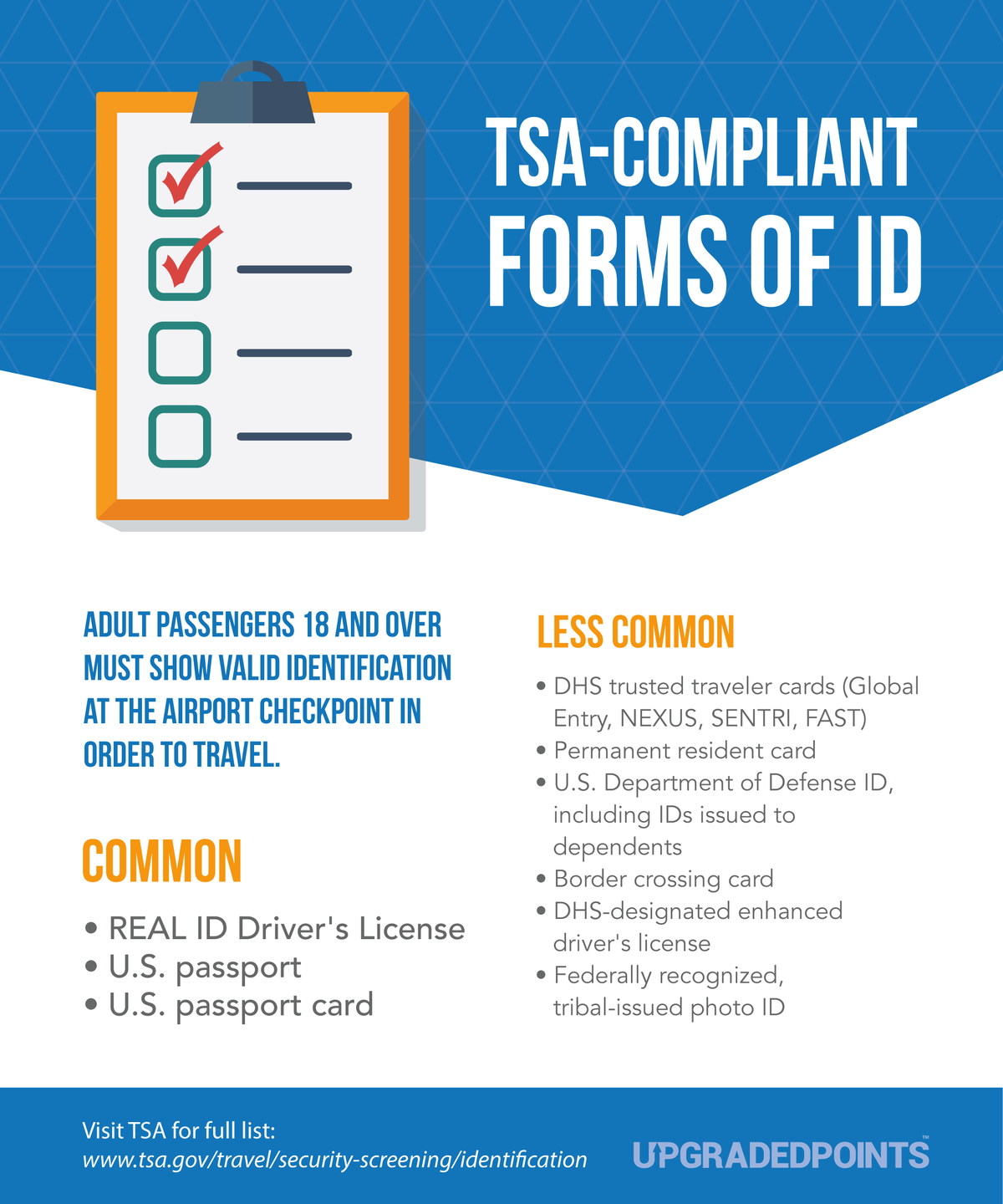
As you can see, the most common alternatives to a REAL ID is a U.S. passport or a U.S. passport card .
Other less common items are DHS Trusted Traveler cards ( Global Entry , NEXUS , SENTRI , FAST), permanent resident cards, Department of Defense IDs, enhanced driver’s licenses, and federally recognized tribal-issued photo IDs.
For more information on acceptable forms of identification for boarding aircraft, please see TSA’s website . However, it should be noted that if on or after May 7, 2025, you cannot provide an acceptable form of identification, you will not be permitted through the security checkpoint to board your flight.

How Much Does a REAL ID Cost?
REAL ID prices vary significantly throughout the country. Prices are set by the state, along with the process for getting a REAL ID. Below is a map with information on the cost and process in each state.
We were interested in estimating just how much revenue states might be bringing in due to the new REAL IDs. For this, we used the cost from the above numbers and multiplied them by the estimated number of drivers in each state, according to information from the Department of Transportation and Federal Highway Administration.
This estimation is based on what we would consider the max possible revenue (if every driver in each state got a new license for the REAL ID Act). Because the new IDs are not mandatory, we understand that not everyone may get one. However, this is an approximation of revenue.
TSA does not require children under 18 to provide identification when traveling with a companion within the U.S. The companion will need acceptable identification, though.
Airlines may demand proof of the child’s age, such as a birth certificate or passport, but these requirements aren’t regulated by TSA. Contact the airline for more information.
Now is the time to make sure you know the requirements to be REAL ID-compliant.
In some states, it may take a few weeks or longer to get an appointment at your local DMV. By taking steps towards compliance now, you can avoid the last-minute rush and be ready to go long before May 7, 2025.
Frequently Asked Questions
What is the real id card.
A REAL ID is a form of identification that meets increased security standards for state-issued driver’s licenses and identification cards. Travelers will be required to provide either a REAL ID or another TSA-approved form of identification to fly after May 7, 2025.
Which states have REAL ID?
Currently, all states are either in compliance with the REAL ID Act or have an extension in place. This means that they are currently able to issue REAL IDs.
While all states are issuing REAL IDs, you can still get a non-REAL ID license as well. Be sure you know what you are getting when you show up!
Do you need a REAL ID to fly?
A REAL ID is a valid form of identification you can use to fly. However, there are many other TSA-approved forms of identification that are also acceptable. You will still need your U.S. passport to travel internationally.
Do I need a REAL ID to fly domestic?
No, a REAL ID isn’t required to fly within the United States. However, starting on May 7, 2025, you will need a REAL ID or another TSA-approved form of identification to fly within the U.S.
Be sure to check out our graphic above for other documents that will be accepted at airport security if you don’t have a REAL ID.
Will REAL ID work as a passport?
If you are traveling internationally, you still need your U.S. passport, as a REAL ID does not replace your passport. If you are traveling domestically, you will only need 1 valid form of identification — either your REAL ID or your passport, not both.
What documents are needed for a REAL ID?
States require you to go to your local DMV and present 1) proof of identity, 2) proof of your Social Security number, 3) 2 proof of residency documents, and 4) if applicable, a proof of name change document.
See our checklist above for examples of each of these items as well as more information on how to obtain a REAL ID.
Do my kids need a REAL ID?
TSA does not require children under 18 to provide identification when traveling with a companion within the U.S. So as long as you have your documents in order, kids will not need a REAL ID.
What is the purpose of REAL ID?
According to the DHS, the purpose of the REAL ID Act “is to make our identity documents more consistent and secure.” It provides a set of standards for the issuance of driver’s licenses and other identity documents.
Can I fly with my regular ID?
You can fly with your regular ID until May 7, 2025. Following that date, you will either need a REAL ID or another TSA-approved form of ID.
How long do REAL IDs last?
This varies by state. However, REAL IDs have the same validity as other state-issued driver’s licenses. This is typically anywhere from 3 to 8 years depending on your state and age. Here is a comprehensive list by state and age.
Is the REAL ID like a driver's license?
A REAL ID can be the same document as your driver’s license. But not all driver’s licenses are REAL IDs.
We know this can be complicated, but a REAL ID driver’s license has additional technology, making it harder to forge. In addition, you must provide additional verification documents (such as multiple forms of ID and residence proof) to get a REAL ID.
Can a REAL ID be used as a passport?
A REAL ID cannot be used for international travel. You must still have your passport to travel internationally.
What is REAL ID vs. enhanced ID?
An enhanced ID is a type of REAL ID for U.S. citizens who live in Michigan, Minnesota, New York, Vermont, and Washington. Canadian citizens residing in British Columbia and Manitoba are eligible for EDLs.
In addition to serving as a driver’s license, enhanced IDs are a convenient way to get into Canada, Mexico, or the Caribbean through a land or sea port of entry (not by air).
What is a REAL ID vs. a passport card?
A passport card can be used for entering the U.S. at land border crossings and sea ports of entry from Canada, Mexico, the Caribbean, and Bermuda. You can also use it to fly domestically as an alternative to a REAL ID, but not for any international flights.
You still need a driver’s license to drive a motor vehicle.
What does "not for Real ID Act purposes" mean?
“Not for Real ID Act purposes” means that the ID can’t be used for identification for a domestic flight (from May 7, 2025) or to enter a federal facility such as a military base.
Was this page helpful?
About Christy Rodriguez
After having “non-rev” privileges with Southwest Airlines, Christy dove into the world of points and miles so she could continue traveling for free. Her other passion is personal finance, and is a certified CPA.
INSIDERS ONLY: UP PULSE ™

Get the latest travel tips, crucial news, flight & hotel deal alerts...
Plus — expert strategies to maximize your points & miles by joining our (free) newsletter.
We respect your privacy . This site is protected by reCAPTCHA. Google's privacy policy and terms of service apply.
Related Posts
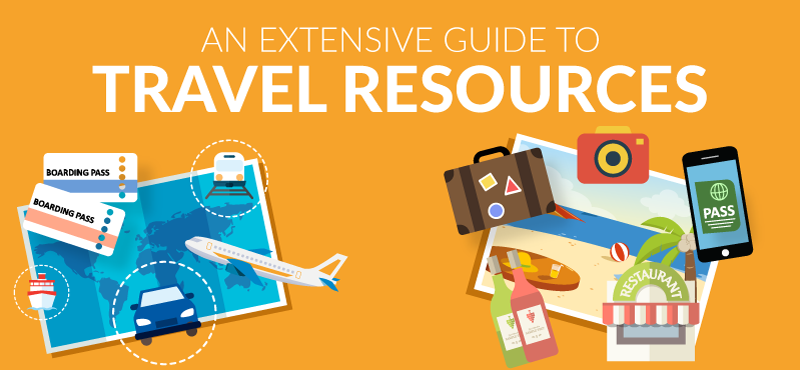
UP's Bonus Valuation
This bonus value is an estimated valuation calculated by UP after analyzing redemption options, transfer partners, award availability and how much UP would pay to buy these points.
TSA Requirements and Advisements for Air Travel
The Transportation Security Administration, or TSA , updates travel requirements and issues information for traveler’s awareness to keep everyone as safe as possible while traveling. Even though it can be a nuisance, we must follow the rules, which seem to change often.
TSA asks travel agents to make their customers aware of tips and requirements before they go.
- Give a printed or email notice concerning the liquid rules for carry-on bags, particularly for travelers flying infrequently.
- Ask customers when they flew last and update them on airport security procedures.
- Give travelers the web page, www.tsa.gov, for questions they may have.
- Inform travelers on the current acceptable forms of ID.
TSA now requires airlines to collect the exact name on ID, plus date of birth, and redress number if a traveler has been issued one. Travel agents and tour operators must collect this information when making airline reservations. Travelers may be denied boarding or delayed if the information on their reservations is not accurate.
Redress number
Secure Flight is the behind the scenes watch list issued by the TSA. For travelers frequently asked to go through extra scrutiny at the airport, or having screening issues, a redress number may be important. This advanced program will allow the traveler to set up an inquiry as to why this is happening. After applying, a redress number may be given to attach to an airline reservation, and hopefully eliminate the extra scrutiny.
Carry-on Luggage Guidelines
- Travelers are allowed 3.4 oz (100ml) bottles in a clear 1-quart zip-top bag per passenger. This enables the security officers to check and clear items quicker collected into one bag separated from the carry-on bag. Some bottled water and beverages can now be purchased after screening that can be brought aboard the plane.
- Medications, food, and baby formula are allowed in limited quantities. Check with the airline or TSA for specific questions. They need to be declared at the security checkpoint.
- Items such as box cutters, knives, and razor blades are not permitted in carry-on bags. Sporting goods such as baseball bats and golf clubs are not permitted, along with tools such as hammers. Scissors with blades less than 4 inches and disposable razor blades are permitted in carry-on bags.
- If in doubt, the items should not be put in the carry-on bag, but be sure it is suitable then to put in checked bags.
Checked bags
Checked bags will also be scanned, and can be opened and searched as well. Any sharp objects in checked luggage should be wrapped as not to harm baggage handlers that may inspect your checked luggage.
From time to time, the State Department issues alerts for US citizens traveling to destinations such as Europe. The State Department suggests registering travel arrangements with the Consulate Section of the U.S. Embassy, before traveling. The most recent security information can be obtained by calling 1-888-407-4747 from the U.S.A. and Canada.
When in doubt, check the TSA web pages, as rules for flying change often. Travel professionals have an increasing amount of responsibility for making sure their customers fly without interruption.
The 12 Best Carry-On Luggage of 2024, Tested and Reviewed
Keep These Items out of Your Carry-On Bag
The 8 Best Luggage Sets of 2024, Tested and Reviewed
Best Ways to Prepare for Airport Security Screenings
The 7 Best Travel Toiletry Bottles of 2024, Tested and Reviewed
Dealing With Lost, Damaged, or Stolen Luggage While Flying
The 11 Best Carry-on Backpacks of 2024, Tested and Reviewed
3-1-1 Rule for Liquids in Carry-on Bags
Top Flying with Luggage Tips
Small Air Travel Upgrades You Can Totally Afford
The 4 Best Luggage Trackers of 2024, Tested and Reviewed
Baggage Wrapping Service Offers Peace of Mind for Air Travelers
The 7 Best TSA-Approved Locks of 2024
The 10 Best Places to Buy Luggage of 2024
How to Use the Airport's Self-Service Check-In Kiosks
How to Take Your Service Animal Through Airport Security
An official website of the United States government Here's how you know
Official websites use .gov A .gov website belongs to an official government organization in the United States.
Secure .gov websites use HTTPS A lock ( Lock A locked padlock ) or https:// means you’ve safely connected to the .gov website. Share sensitive information only on official, secure websites.
Frequently Asked Questions
⚠ The COVID-19 Public Health Emergency expired as of May 11, 2023. This site will no longer be updated and will remain online for historical purposes only.
For current COVID-19 guidance, please visit the Centers for Disease Control and Prevention (CDC) .
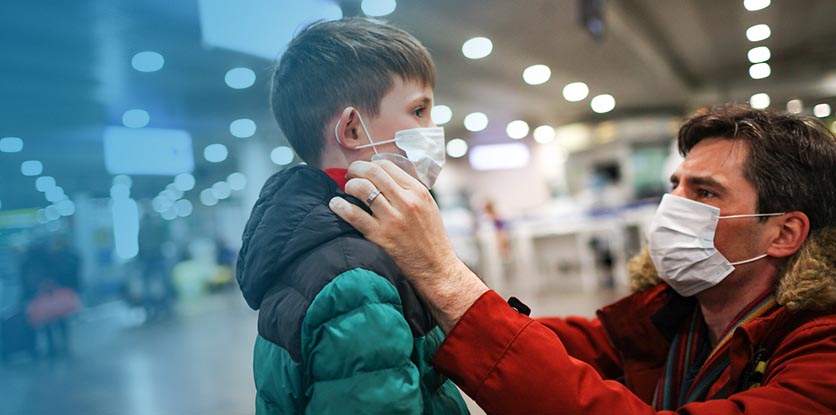
- Can I wear a mask to the TSA checkpoint? Yes, CDC recommends travelers wear a mask throughout their travel journey. Travelers may be asked to adjust their mask for identity verification or remove it briefly if it alarms the security screening equipment.
Can I request that TSA officers use new gloves during my screening? Yes. TSA officers are required to wear nitrile gloves when conducting screening duties and to change them following each pat-down and upon passenger request.
Can I bring my own filled water bottle through the TSA checkpoint? No, you are not permitted to bring your own filled water bottle that exceeds 3.4 ounces through the checkpoint. Many airports now offer touchless refilling stations past security that enable travelers to fill empty bottles and containers they bring from home. Consult the directory or ask a local official for locations in your departure airport.
Do I need to remove electronics from my carry-on bags?
Yes, you should plan to remove personal electronic devices larger than a cell phone from your carry-on bag and put them in a separate bin with nothing placed on or under them for security screening. (This does not apply to TSA PreCheck™ passengers.) Some airports are using new Computed Tomography (CT) technology that allows you to keep electronics in your carry-on luggage. Passengers will be advised on the use of CT scanners at the checkpoint and of any alternate procedures.
Can TSA still open and go through my checked luggage? What precautions are being taken to reduce possible contamination? Yes, TSA may inspect your checked baggage during the screening process. If your property is physically inspected, TSA will place a notice of baggage inspection inside your bag. To reduce the likelihood of contamination, TSA officers are changing their gloves after each bag check and conducting enhanced sanitation of baggage screening areas.
What is the status of REAL ID enforcement in light of COVID-19?
The Department of Homeland Security has extended the deadline for REAL ID enforcement to May 7, 2025. Visit the REAL ID website for more information.
What happens if a passenger is unruly and does not comply with an airline’s policies and/or causes an inflight disruption or distraction for the crew?
Federal law prohibits physically assaulting or threatening to physically assault aircraft crew or anyone else on a civil aircraft. Passengers are subject to civil penalties for such misconduct, which can threaten the safety of the flight by disrupting or distracting cabin crew from their safety duties. Additionally, federal law provides for criminal fines and imprisonment of passengers who interfere with the performance of a crewmember’s duties by assaulting or intimidating that crewmember.
What happens if there is a sick passenger on an international or domestic flight?
Under current federal regulations, pilots must report all onboard illnesses and deaths to CDC before arriving to a U.S. destination. According to CDC illness response protocols, if a sick traveler has a serious contagious disease during air travel, CDC works with local and state health departments and international public health agencies to contact exposed passengers and crew. Be sure to give the airline your current contact information when booking your ticket so you can be notified if you are exposed to a sick traveler on a flight. For more information, see the CDC web page Protecting Travelers’ Health from Airport to Community: Investigating Contagious Diseases on Flights .
Can flying on an airplane increase my risk of getting COVID-19?
Most airlines and airports are enhancing their cleaning and passenger health protection protocols due to COVID-19, but air travel requires spending time in security lines and airport terminals, which can bring you in close contact with other people and frequently touched surfaces. This may increase your risk for exposure to the virus that causes COVID-19.
Most viruses and other germs do not spread easily on flights because of how air circulates and is filtered on airplanes (the air in an airplane cabin is fully renewed every 2-3 minutes, which is more frequent than most other locations in which people spend time). However, social distancing is difficult on flights, and you may have to sit near others, sometimes for hours. This is why CDC recommends the wearing of a face mask an important additional measure against exposing yourself or others to COVID-19. It is important to follow basic guidance on wearing a face mask and frequently washing your hands or using hand sanitizer with at least 60% alcohol. For more information see CDC’s Travel During the COVID-19 Pandemic .
International Travel Requirements
- What should passengers provide to airlines to show they are fully vaccinated? Both U.S. citizens and foreign nationals who are fully vaccinated should travel with proof of their vaccination status to provide to their airline prior to departure to the United States. That proof of vaccination should be a paper or digital record issued by an official source and should include the traveler’s name and date of birth, as well as the vaccine product and date(s) of administration for all doses the traveler received.
- How does the exemption from full vaccination for children work? Children under 18 are exempted from the vaccination requirement for foreign national travelers, given both the ineligibility of some younger children for vaccination, as well as the global variability in access to vaccination for older children who are eligible to be vaccinated.
- How is the United States government determining exceptions to the vaccination requirement for foreign nationals? The presidential proclamation and CDC order include a very limited set of exceptions from the vaccination requirement for foreign nationals. These include exceptions for children, certain COVID-19 vaccine clinical trial participants, those with rare medical contraindications to the vaccines, those who need to travel for emergency or humanitarian reasons, those who are traveling on non-tourist visas from countries with low-vaccine availability, members of the armed forces and their immediate families, airline crew, ship crew, and diplomats.
*All information developed in accordance with CDC guidelines.

An official website of the United States government
Here’s how you know
Official websites use .gov A .gov website belongs to an official government organization in the United States.
Secure .gov websites use HTTPS A lock ( Lock A locked padlock ) or https:// means you’ve safely connected to the .gov website. Share sensitive information only on official, secure websites.
- About REAL ID
Are You REAL ID Ready?
On May 7, 2025, U.S. travelers must be REAL ID compliant to board domestic flights and access certain federal facilities.
Find out if you’re REAL ID ready with our interactive tool, or select your state or territory!
- Are you planning to fly domestically or visit a Federal facility after May 7, 2025?
- Does your Drivers License / ID have a star (and/or flag) or say "Enhanced"?
You're REAL ID ready! You will need this ID to board domestic flights and may need this or another acceptable form of identification to visit federal facilities.
- Do you have a passport?
A passport is an acceptable form of identification and may be used in lieu of a REAL ID Drivers License or ID to board domestic flights and visit federal facilities.
- Click here to see if you have one of these acceptable forms of identification that may also be used to board domestic flights and visit federal facilities (link will open in a new window). Do you have one of these?
- These alternate forms of identification may be used in lieu of a REAL ID Drivers License or ID at the airport to board domestic flights and when visiting federal facilities.
You're not REAL ID ready! Important: if you want to board domestic flights or visit federal facilities beginning May 7, 2025 you must have a REAL ID or another acceptable form of identification. Select your state or territory to visit your local DMV to learn more.
You might not need a REAL ID. Click on your state or territory below to visit your local DMV to learn more.
Select a state or territory: -- Alabama Alaska American Samoa Arizona Arkansas California Colorado Connecticut Delaware District of Columbia Florida Georgia Guam Hawaii Idaho Illinois Indiana Iowa Kansas Kentucky Louisiana Maine Maryland Massachusetts Michigan Minnesota Mississippi Missouri Montana Nebraska Nevada New Hampshire New Jersey New Mexico New York North Carolina North Dakota Northern Mariana Islands Ohio Oklahoma Oregon Pennsylvania Puerto Rico Rhode Island South Carolina South Dakota Tennessee Texas U.S. Virgin Islands Utah Vermont Virginia Washington West Virginia Wisconsin Wyoming
- REAL ID Act of 2005

Deadline: May 7, 2025

Do you need a passport to travel in the U.S. in 2024?
T ravel is tricky enough, but to add to the already confusing world of air travel, the U.S. government has been teasing us with updated identification requirements for what seems like forever. After years of changed dates, extended deadlines, and general defiance at the state level, there’s still a lot of confusion around the REAL ID Act, particularly when it comes to modern air travel . So, do you need a passport to travel within the U.S. once this goes into effect?
Direct answer: You will not need a passport to travel within the US in 2024 or 2025, when the REAL ID Act goes into effect, though you can use one. Most people will use a REAL ID compliant driver’s license. These are already being issued and can be identified by the star in the upper right hand corner of the ID.
Read on to see more about what this means and how do you prepare if your ID isn’t already compliant? We’ll clear a few things up regarding this issue and explain the use of your passport when traveling domestically.
The REAL ID Act basics
For starters, the REAL ID Act was slated to become law back on Oct. 1, 2020. However, the unprecedented circumstances of the last few years — traveling during the COVID-19 pandemic in particular — pushed the execution date. Now that date has been changed yet again . According to the Department of Homeland Security (DHS), all U.S. travelers must meet the REAL ID requirements to board domestic flights by May 7, 2025 (it was last slated for May 3, 2024, with October 1, 2021, and then to May 3, 2024, as the dates before then). While you may not need a passport to travel, you will need a REAL ID.
Every state will require a REAL ID
If you thought maybe your state wouldn’t comply with the act, we’re sorry to say that every territory and state will require a REAL ID. Some states have already started issuing them, so you may have one.
The REAL ID won’t get you everywhere
For trips to Mexico (by land) and Canada, and other international travel , you will still need a passport to enter. The REAL ID isn’t a substitute for your passport.
The REAL ID isn’t a passport
When you get your new ID, it doesn’t replace a passport. This can’t be used to fly outside of the U.S., but it could be used as a second form of ID. It’s also not a visa, it’s just your ID taken up a notch.
Do I need a passport to fly domestically?
According to the U.S. Transportation Security Administration (TSA), all adult passengers (18 and above) must show valid identification at the airport to travel. The identification must show your picture, name, and state of residence. It doesn’t necessarily need to be your passport, which means you can fly domestically in the U.S. in 2024 without a valid passport for travel.
If you don’t have a passport, there are other acceptable forms of identification, including:
- U.S. passport card
- State-issued driver’s license
- DHS trusted traveler card
- State-issued Enhanced Driver’s License
- U.S. Merchant Mariner Credential
- Border crossing card
- Permanent resident card
- U.S. Department of Defense (DoD) ID
- Tribal-issued photo ID
Believe it or not, even if you don’t have any form of ID because, say, you forgot it at home, it’s lost, or you’re a “sovereign citizen,” you’re still able to fly within the U.S. You’ll need to complete an identity verification process as required by the TSA.
Don’t plan on breezing through airport security , though, because you’ll be subject to additional (i.e., lengthier, more intensive) screening. Children under the age of 18 are not expected to provide identification when traveling domestically.
What kind of ID do you need to travel domestically within the U.S.?
For domestic US travel in 2024 , an in-date driver’s license or other DMV-issued photo identity card with work. For other methods of identification, check the TSA’s acceptable identification guidelines .
Starting on May 7, 2025 , you will need a new REAL ID if you plan to use an ID to board. Fortunately, you are likely to already have one. As, according to the DHS, “All 50 states are now in full compliance issuing these cards, with most states becoming compliant in the last four years.” Again, a REAL ID has a star in the upper right hand corner. If you happened to renew your last ID before your state was compliant, you’re now able to receive a REAL ID-compliant version at your next visit. In the absence of a REAL ID, you will be able to use a valid passport, a U.S. military ID, or a federal government PIV card for domestic travel.
Without a passport, REAL ID-compliant card, or any other accepted forms of identification, you won’t be allowed through TSA checkpoints, meaning you won’t be able to fly within the U.S.
Do you need a REAL ID to fly in the U.S.?
- If the new date sticks, when it gets here, then yes, you will.
- You’ll also need it if you want to enter federal facilities.
Beginning May 7, 2025, if they don’t have a passport, all U.S. travelers will need a REAL ID to fly for domestic travel. The ID will be required to access any federal facility, so, for example, you won’t be able to visit some national monuments, federal buildings, or loved ones at military installations without one.
This law will apply to all 50 states and territories, including Guam, the U.S. Virgin Islands, the District of Columbia, and Puerto Rico. Without the ID, you could still use your passport to fly locally. But that could still be a potential challenge for the almost 60% of U.S. citizens who don’t have a passport.
You get your REAL ID through your local Department of Motor Vehicles office, AAA, or regional state offices. It’s possible to complete the necessary documentation online before visiting the office, too, so be sure to check the minimum requirements before applying.
What do you need to travel within the U.S.?
When traveling as a resident, you’ll need a valid passport, driver’s license, state ID, or military ID. Before traveling, be sure to check your identification to ensure it is valid and current. Also, take time to learn about the laws of the state you’re flying to — that helps avoid delays and frustrations.
U.S. citizens can also use state-issued enhanced driver’s licenses (EDLs) to fly locally. Know that EDLs are only available in select states, including New York, Washington, Minnesota, Vermont, and Michigan. They’re typically given to residents in states close to U.S. borders to comply with the Western Hemisphere Travel Initiative .
If you’re a foreign national traveling within the U.S., you’ll need your passport, so be sure to keep your passport safe while traveling. Flying within the U.S. without a passport as a foreign national could be quite stressful.
On the other hand, green-carded residents must have their regular photo ID and green card to fly within the U.S. The card also functions as a driver’s license or other ID, and you’re not required to have a passport for domestic travel.
Where can I fly without a passport?
- The sky is the limit — within the U.S.
As of 2024, there are no states that require passports from U.S. citizens to fly domestically. Your airline or the TSA should never ask you to present a valid passport. Of course, you could carry it with you for additional photo identification in case you lose your other forms of ID.
Bottom line: You can fly to all 50 states and surrounding territories without a passport. Just make sure to carry either your driver’s license or a state-issued ID. To avoid frustrations in the future, ensure your driver’s license and other ID are REAL-ID compliant before May 2025. You’ll need a passport to travel internationally , so it’s vital not to leave it at home if your travel plans are likely to include leaving the U.S.
If you have a trip planned for the next few years, it will be business as usual, where you won’t have to worry about having a passport or REAL ID, anyway. But after that, you will need a REAL ID, and if you don’t have one, you’ll need a valid passport. Either get ready to get your passport — which is good for 10 years — or your REAL ID before 2025, not forgetting about how long it could take to get that passport. Things will probably be a bit rough, and we’ll have some growing pains while everyone adjusts to the new REAL ID rules, so it might be better if you have a passport to be safe.
The post Do you need a passport to travel in the U.S. in 2024? appeared first on The Manual .

- Cover Letters
- Jobs I've Applied To
- Saved Searches
- Subscriptions
Marine Corps
Coast guard.
- Space Force
- Military Podcasts
- Benefits Home
- Military Pay and Money
- Veteran Health Care
- VA eBenefits
- Veteran Job Search
- Military Skills Translator
- Upload Your Resume
- Veteran Employment Project
- Vet Friendly Employers
- Career Advice
- Military Life Home
- Military Trivia Game
- Veterans Day
- Spouse & Family
- Military History
- Discounts Home
- Featured Discounts
- Veterans Day Restaurant Discounts
- Electronics
- Join the Military Home
- Contact a Recruiter
- Military Fitness
‘Indefinite’ Defense Department IDs Inconvenience Air Travelers, May Be Dropped As Acceptable Identification
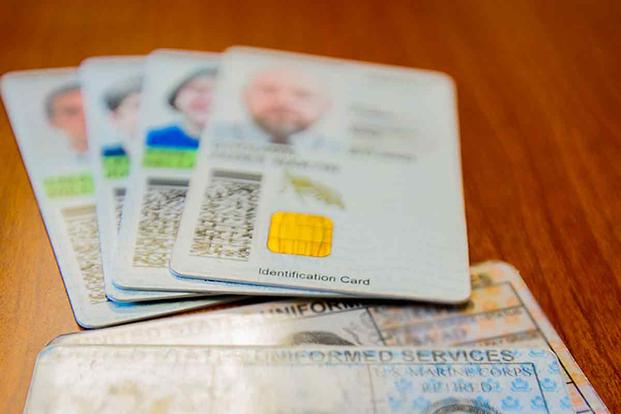
Military retirees and some spouses or dependents whose next-generation Department of Defense identification cards have an "INDEF" expiration date continue to face problems using their IDs to traverse Transportation Security Administration checkpoints at U.S. airports.
And a potential solution under consideration at TSA -- that the agency drops the IDs, known as USIDs, as acceptable forms of identification when stricter travel requirements are implemented next year -- is sure to irritate those who like using their military IDs instead of a state driver's license or passport for travel.
Nearly a dozen military retirees have contacted Military.com in the past two years with concerns that their ID cards marked INDEF, meaning they have an indefinite expiration date, don't work with TSA screening technology in airports across the country.
Read Next: Pentagon's Second Review of Abbey Gate Attack Finds Troops Didn't See Bomber Before the Explosion
Former service members have run into the issue at Chicago O'Hare International, Seattle-Tacoma International, Orlando International, Tampa International, San Diego International and elsewhere.
According to TSA press secretary R. Carter Langston, the problem centers around USIDs that lack an expiration date. The "INDEF" designation cannot be read by the TSA's Credential Authentication Technology. When the CAT unit does not detect an expiration date, the CAT screen will display an "EXPIRED" alert, according to Langston.
The TSA officer is supposed to ask for another acceptable form of ID that can be read by the CAT unit, Langston said. If the passenger does not have another acceptable form of ID, the officer "will conduct manual inspection of the DoD ID presented as these IDs are currently acceptable forms of ID," Langston said in a statement.
The issue is largely a matter of inconvenience, since many people travel with a driver's license, passport or other form of identification.
But for DoD ID card holders, it could become a major problem beginning May 7, 2025, when all travelers and visitors to the U.S. will be required to have a passport, a state-verified REAL ID or another form of identification designated as acceptable by TSA.
Since the REAL ID Act of 2005 was passed, Defense Department IDs holders have been told their IDs are compliant and acceptable in lieu of a REAL ID and many have not bothered to get a REAL ID compatible state identification card.
They may need to or begin traveling with a passport, because given the ongoing issues, TSA is considering dropping DoD IDs from their list of accepted identification before the REAL ID requirement goes into effect, according to a source with knowledge of ongoing discussions between TSA and the Defense Department.
The Defense Department did not respond to a request for comment on the proposal, and Langston said he would not "confirm or deny discussions that are pre-decisional in nature."
But the proposal does not sit well among some former service members who spent decades serving their country and take pride in carrying a military ID.
"You can get on any military base in the country, but you can't get on an airplane with a military ID card? I don't agree with that at all," said a military retiree based in Washington state who requested that his name not be used to protect how he learned of the proposal.
The source added that the decision is not final and discussions were ongoing.
The Defense Department updated the new IDs, known as USID, for active-duty family members, military retirees and their dependents, reservists and Medal of Honor recipients in 2020, the first upgrade to the cards since 1993.
The USID cards look similar to Common Access Cards, which are issued to active-duty personnel, but they don't have a built-in chip. They were created to have durable lamination, full-color photos and enhanced security features to make them less able to counterfeit or misuse.
When the USIDs were introduced, TSA's scanning system was unable to read their barcodes. That issue largely was fixed in 2022 with a software update , and DoD ID cards work for most individuals whose cards have an expiration date.
But the problem continues for IDs with the "INDEF" date. And retirees aren't happy about it.
"It's been my assumption all along [that I could fly with a DoD ID card]," said the Washington-based retired officer. "I had an old ID until just a couple of months ago, and it worked just fine."
Related: Defense Department Expands ID Card Renewals by Mail to US-Based Retirees, Dependents
Patricia Kime

You May Also Like

Top Navy and Army officials faced tough questions Tuesday from lawmakers on what steps they are taking to prevent child abuse...

The U.S. Supreme Court decision handed down Tuesday could affect up to 1.7 million veterans, according to the retired Army...

The retired general, Antonio Taguba, told jurors that the contractor, Steven Stefanowicz, even tried to intimidate the...

The Army says it will continue the suspension of horse-drawn funeral services at Arlington National Cemetery after roughly a...
Military News
- Investigations and Features
- Military Opinion
Select Service
- National Guard
Most Popular Military News

The maintenance-embattled USS Boxer is heading back to San Diego just 10 days after deploying due to an engineering issue, as...

The Louisiana soldiers are spaced in groups of two or three over the 1.5 mile, 400-yard-wide strip of land.

The roughly $11 million deal set the service up to be the premier partner for the league's inaugural season, which started...

A Military.com investigation into military day care centers revealed that service branch rules generally prioritize...

The recommendation on boosting paychecks is part of the final report from the House Armed Services Committee's military...
Latest Benefits Info
- Military Tuition Assistance (TA) Overview
- GI Bill Monthly Housing Allowance
- The Active-Duty Montgomery GI Bill
- Fertility Benefits for Active-Duty Service Members
- Retirees, VA Disability Recipients to Get Biggest Pay Raise Since 2012
More Military Headlines

Gen. David Allvin, the Air Force chief of staff, told airmen in an emailed memo that as he nears the six-month mark in his...
- Report on Child Abuse at Military Day Cares Sparks Tough Questions for Navy, Army Leaders on Capitol Hill
- Supreme Court Rules in Favor of Army Veteran Over Extended GI Bill Benefits
- Retired Army General's Testimony Links Private Contractor to Abu Ghraib Abuses
- Air Force Chief of Staff Highlights Quality-of-Life Updates for Airmen in Latest Memo to the Force
- Florida Honors Tuskegee Airmen with State Holiday While Alabama Still Doesn't
- New Recruiting Programs Put Army, Air Force on Track to Meet Enlistment Goals. Navy Will Fall Short
- USS John C. Stennis Leaves Newport News Shipbuilding Dry Dock, Overhaul 65% Complete
Military Benefits Updates
- Military Child Care Fees
- The Mental Burden of Using Military Benefits
- Former Marine 'Neo-Nazi' Sentenced to 9 Years in Prison for Firebombing of Planned Parenthood
- Pentagon's Second Review of Abbey Gate Attack Finds Troops Didn't See Bomber Before the Explosion
- Marines in Uniform Were Photographed at Mar-a-Lago Event. Service Says It Was for a Veterans Charity.
- 55 Coast Guard Academy Cadets Disciplined in Cheating Scandal
- 'HELP' Message on Remote Island Saves Sailors Stranded for a Week, Coast Guard Says
- Coast Guard 'Indo-Pacific Support Cutter' Returns to Honolulu
Entertainment
- The Incredible Wartime Career of Lee Miller, Model-Turned-World War II Combat Photographer
- How the OJ Simpson Verdict Overshadowed a Watershed Moment for Atomic Veterans
- PBS' 'After Action' Takes a Personal Look at the Lives of Veterans Forever Changed by Military Service

An official website of the United States government
Here’s how you know
Official websites use .gov A .gov website belongs to an official government organization in the United States.
Secure .gov websites use HTTPS A lock ( Lock A locked padlock ) or https:// means you’ve safely connected to the .gov website. Share sensitive information only on official, secure websites.
TSA at JFK International Airport now using credential authentication technology to improve checkpoint screening capabilities
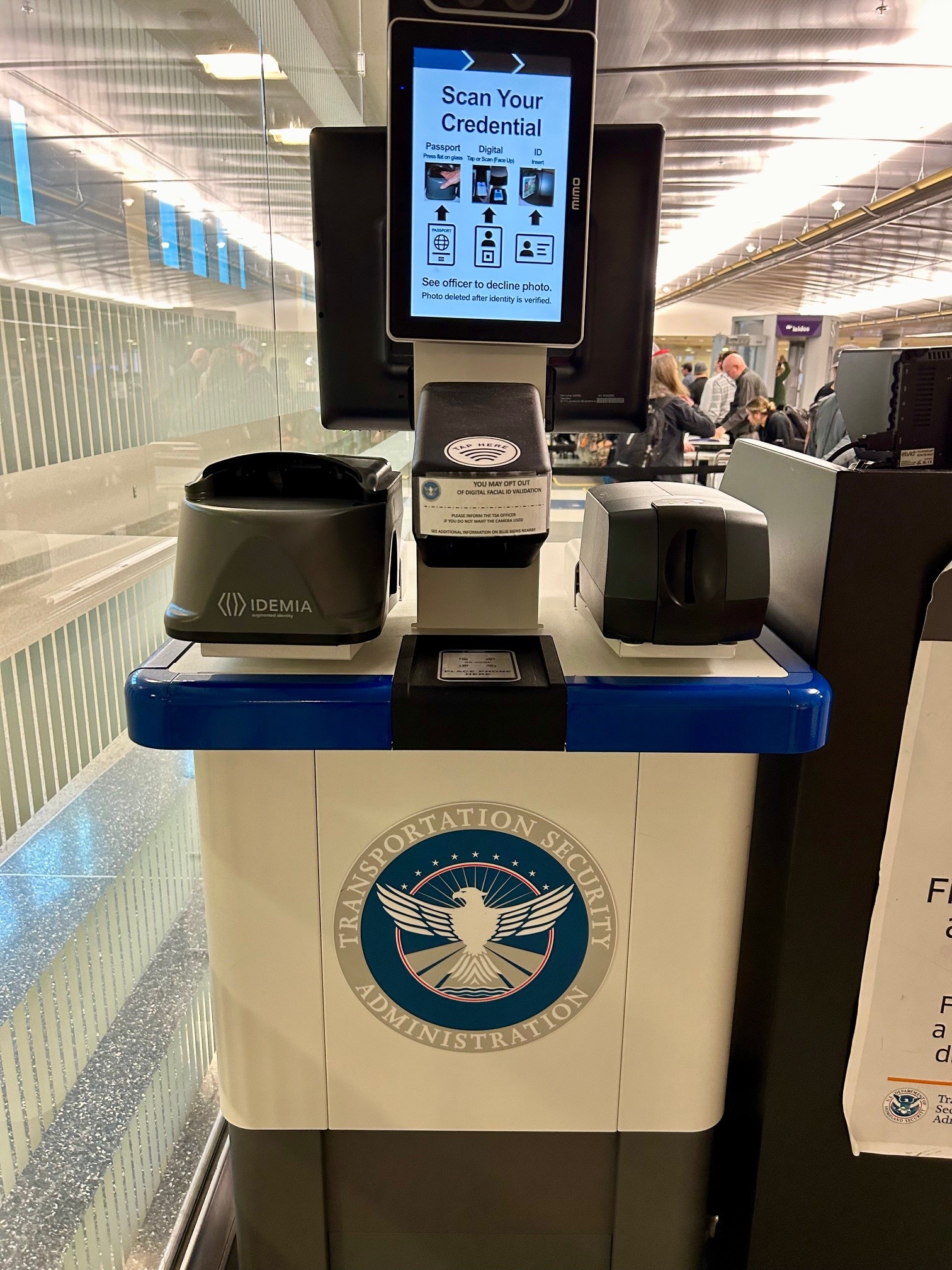
NEW YORK — New technology that confirms the validity of a traveler’s identification (ID) and confirms their flight information in real time is now in use at the Transportation Security Administration (TSA) security checkpoints at JFK International Airport.
This deployment is the latest generation of Credential Authentication Technology (CAT) to verify the identity of travelers. First generation CAT units are designed to scan a traveler’s photo identification, confirm the traveler’s identity as well as their flight details. The new CAT units, referred to as CAT-2, have the same capabilities, but are also equipped with a camera that captures a real-time photo of the traveler.
CAT-2 compares the traveler’s photo on the ID against the in-person, real-time photo. Once the CAT-2 confirms the match, a TSA officer verifies and the traveler can proceed through the checkpoint, without ever exchanging a boarding pass. The photo is then deleted.
The CAT-2 units are equipped with cameras on tablets and are used to match the face of the person standing at the checkpoint with the face that appears on the traveler’s ID such as the person’s driver’s license or passport. The technology enhances detection capabilities for identifying fraudulent documents at the security checkpoint. The photos are not saved and are only used to match the person standing at the travel document checking podium with the photo on the ID that is being presented.
“Identity verification of every traveler prior to flying is a key step in the security screening process,” said John Essig, TSA’s Federal Security Director for the airport. “This technology enhances detection capabilities for identifying fraudulent IDs such as driver’s licenses and passports at a checkpoint and it increases efficiency by automatically verifying a passenger’s identification. We just want to ensure that you are who you say you are.”
As an additional feature, the unit is touchless meaning that the passengers insert their ID and do not have to hand it to a TSA officer. Thus the units reduce touchpoints and speed the process. Travelers insert their ID, look at the camera and if the ID is validated, the traveler then proceeds into the checkpoint. Even with TSA’s use of these units, travelers still need to check-in with their airline in advance and bring their boarding pass to their gate to show the airline representative before boarding their flight.
“This latest technology helps ensure that we know who is boarding flights,” Essig said. “Credential authentication plays an important role in passenger identity verification. It improves a TSA officer’s ability to validate a traveler’s photo identification while also identifying any inconsistencies associated with fraudulent travel documents.”
The system also confirms the passenger’s flight status by verifying that the individual is ticketed to fly out of an airport on that same day.
CAT-2 units have what is referred to as a “library” of IDs programed into them that allow the technology to authenticate more than 2,500 different types of IDs including passports, military common access cards, Department of Homeland Security Trusted Traveler ID cards, uniformed services ID cards, permanent resident cards, U.S. visas and driver’s licenses and photo IDs issued by state motor vehicle departments.
Photos captured by CAT-2 units are never stored or used for any other purpose than immediate identity verification. Travelers who do not wish to participate in the facial matching process can opt out in favor of an alternative identity verification process.

IMAGES
COMMENTS
Acceptable Identification at the TSA Checkpoint. Adult passengers 18 and older must show valid identification at the airport checkpoint in order to travel. Beginning May 7, 2025, if you plan to use your state-issued ID or license to fly within the U.S., make sure it is REAL ID compliant. If you are not sure if your ID complies with REAL ID ...
The REAL ID Act, passed by Congress in 2005, requires US travelers flying domestically to show TSA agents either a security-enhanced driver's license or ID card or another TSA-approved form of identification, such as a passport. It is an attempt to lower travel risk in response to the attacks of Sept. 11, 2001.
On May 7, 2025, U.S. travelers must be REAL ID compliant to board domestic flights and access certain federal facilities. Find out if you're REAL ID ready with our interactive tool! Are you planning to fly domestically or visit a Federal facility after May 7, 2025? Yes / Don't Know. Does your Drivers License / ID have a star (and/or flag) or ...
Alejandro N. Mayorkas. Beginning * October 1, 2023, every air traveler 18 years of age and older will need a REAL ID-compliant driver's license, state-issued enhanced driver's license, or another acceptable form of ID to fly within the United States. A little more than a year away, the TSA is changing its identification requirements.
The Transportation Security Administration is reminding travelers that beginning October 1, 2020, every traveler must present a REAL ID-compliant driver's license, or another acceptable form of identification, to fly within the United States. TSA has launched a public awareness campaign about the upcoming identification changes to ensure that every traveler is prepared for the airport ...
Now, after years of delays, it is finally kicking into gear. Beginning May 3, 2023, U.S. travelers flying within the United States will need to show Transportation Security Administration agents ...
Beginning October 1, 2020, all U.S. travelers will need a Real ID-compliant license or other approved form of identification to fly. It's important to note that a Real ID is required only for entering airport security checkpoints and boarding aircraft, as well as entering secured federal facilities and nuclear plants.
How to get a REAL ID. When you apply for or renew your driver's license or state identification card, you can choose to make it REAL ID-compliant. Find and visit your state's driver's licensing agency website to see what documentation you will need. Your new card will have the REAL ID star marking at the top right.
Airlines may demand proof of the child's age, such as a birth certificate or passport, but these requirements aren't regulated by TSA. Contact the airline for more information. Final Thoughts. Now is the time to make sure you know the requirements to be REAL ID-compliant.
Important notes from the TSA: If your driver's license or state-issued ID expired on or after March 1, 2020, you can still use it as acceptable ID at the checkpoint. TSA will accept expired driver's licenses or state-issued ID a year after expiration. TSA ID requirements are changing on May 7, 2025.
TSA now requires airlines to collect the exact name on ID, plus date of birth, and redress number if a traveler has been issued one. Travel agents and tour operators must collect this information when making airline reservations. Travelers may be denied boarding or delayed if the information on their reservations is not accurate.
This is why CDC recommends the wearing of a face mask an important additional measure against exposing yourself or others to COVID-19. It is important to follow basic guidance on wearing a face mask and frequently washing your hands or using hand sanitizer with at least 60% alcohol. For more information see CDC's Travel During the COVID-19 ...
Airline passengers, some not wearing face masks following the end of Covid-19 public transportation rules, wait at a Transportation Security Administration (TSA) checkpoint to clear security ...
Who needs a REAL ID-compliant identification to fly? Starting May 7, 2025, every air traveler 18 years of age and older will need a REAL ID-compliant driver's license, state-issued enhanced driver's license, or another acceptable form of ID This indicates a link to an external site that may not follow the same accessibility or privacy policies as Alaska Airlines.
On May 7, 2025, U.S. travelers must be REAL ID compliant to board domestic flights and access certain federal facilities. Find out if you're REAL ID ready with our interactive tool, or select your state or territory! Are you planning to fly domestically or visit a Federal facility after May 7, 2025? Yes / Don't Know. No.
Travel ID Information. Effective May 7, 2025, only the Arizona Travel ID (driver license or ID card), a U.S. passport and other federally approved identification will be accepted at TSA airport security checkpoints for domestic travel.. Apply for a Travel ID. Current Arizona residents: Visit AZ MVD Now to gather your documents and make an appointment for your Travel ID.
Travelers will begin seeing new signs at airports nationwide in the coming weeks to remind people that REAL ID-compliant licenses or other acceptable forms of ID, such as a valid passport, federal government PIV card or U.S. military ID, will be mandatory for air travel beginning on October 1, 2020.Critically important, on October 1, 2020, individuals who are unable to verify their identity ...
NOTE: The deadline to obtain a REAL ID-compliant license or state ID is May 7, 2025. All Arizona driver's licenses and IDs are valid for air travel until May 7, 2025, when every traveler will need a REAL ID-compliant license, state ID, or another acceptable form of identification to fly within the United States. Travelers can now reserve an appointment online and upload required documents on ...
According to the U.S. Transportation Security Administration (TSA), all adult passengers (18 and above) must show valid identification at the airport to travel. The identification must show your ...
Travel. TSA PreCheck® expedited screening allows eligible travelers to keep on their shoes, light outerwear, belts and more. Learn more. Be prepared for your next flight. Learn about the checkpoint security screening process and policies. TSA Cares is a resource that provides travelers with disabilities and medical conditions.
And a potential solution under consideration at TSA -- that the agency drops the IDs, known as USIDs, as acceptable forms of identification when stricter travel requirements are implemented next ...
Travelers insert their ID, look at the camera and if the ID is validated, the traveler then proceeds into the checkpoint. Even with TSA's use of these units, travelers still need to check-in with their airline in advance and bring their boarding pass to their gate to show the airline representative before boarding their flight.